

European
Nuclear Society
e-news
issue 37: July 2012
In 1970, Arthur C. Clarke, the award-winning science fiction writer whose pioneering book 2001: A Space Odyssey achieved global iconic status, predicted that satellites would one day “bring the accumulated knowledge of the world to your fingertips, combining the functionality of the Xerox, telephone, television and a small computer, allowing data transfer and video conferencing around the globe”. For many people then, this visionary statement probably appeared to be nothing more than the fanciful ramblings of a fantasy writer. And yet, twenty years later, at CERN, the European nuclear research centre near Geneva, British engineer and computer scientist Sir Tim Berners-Lee, and his Belgian counterpart, Robert Cailliau, proposed to use hypertext "... to link and access information of various kinds as a web of nodes in which the user can browse at will." Their joint proposal later gave birth to one of the modern era’s most universal phenomena - the world-wide-web. The age of the internet was born.
I bet that for most readers, even those of us who grew up long before the spider spun its electronic web, life today without hypertext, web browsers, search engines, online payment, Google, Facebook and Twitter, would seem inconceivable. We spend an increasingly larger amount of our time trawling the web and exploring new ways of accumulating and storing information.
The nuclear science community, weened on innovation, was quick to embrace this new, addictive phenomenon. Since 2003, the monthly average number of visitors to the ENS website has risen from 5,500 to the current average total of over 71,000. ENS also has an expanding Twitter account. In an age when hard copy publications are gradually being replaced by their electronic progeny, ENS NEWS, which readers can summon onto their laptop or I-pad screens in a fraction of a second, is a child of its time. With this in mind, I thought that you might like to know that over the course of the last twelve months, your ENS NEWS accumulated the not inconsiderable total of 100,000 readers. Of course, it’s impossible to tell how many of those readers are ENS members and how many are simply curious navigators surfing public websites. However, I think that it is fair to say that ENS NEWS, the content of which is provided by ENS members for ENS members, does appear to punch above its weight.
Perhaps it is time now to put that theory to the test. You, the reader, are the sole judge of whether the Society’s quarterly magazine satisfies your thirst for information and is worth spending some of your precious time on. So, I would like to urge you to take a few minutes to fill in the following mini satisfaction survey. Your feedback will enable us to learn what you like and don’t like about ENS NEWS; where it needs freshening up or modernising; where it satisfies and where it fails to satisfy your insatiable thirst for information. This information is crucial to us if we are to succeed in our mission to present, four times a year, the best possible quality electronic publication. So, give an honest appraisal of what you think. As Mohatma Gandhi famously said, “Truths never hurts a just cause.”
ENS NEWS would like to wish its readers a relaxing, rewarding and enjoyable summer -whether it be an electronic or electronic-free one. We look forward to hearing from you after the break, refreshed and batteries re-charged!
|
http://www.euronuclear.org/e-news/e-news-37/presidents-contribution.htm


Summertime means vacation time; the perfect occasion to reflect a bit on what has happened and to look forward to the second half of the year. Upcoming conferences, the work of the High Scientific Council (HSC), and that of the Young Generation Nuclear (YGN), currently provide the Board of ENS with the main thrust of its work.
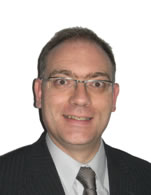 |
2012 started successfully, with three out of the five conferences on this year’s ENS events calendar taking place. PIME, RRFM and TOPSAFE have established themselves as regular fixtures on that calendar and were all very well- attended. The feedback from participants on all three was positive. These conferences are part of the backbone of the work that the Society carries out for its members. Two further high-ranking ENS conferences, TOPFUEL and ENC2012, both of which will take place in Manchester (UK), will add further calcium to that backbone. The outlook is promising, but, nevertheless, I would especially like to focus your attention on the importance of both these events. |
In September, TOPFUEL will bring together specialists from across the globe working in nuclear fuel development. We have received many outstanding papers, which will contribute to what is already a very interesting programme.
ENC2012 will provide the stage for a get-together of the whole European Nuclear Society community. In addition to the technical programme, which will feature papers submitted from all over the world, the conference will be accompanied by a large industry exhibition. Furthermore, for the first time, ENS will organise a careers event, which will run parallel to the conference. This event will bring together our YGN members (and those who might provide the next generation of YGN) and our Corporate Members - their potential future employers. The idea behind this initiative is to enable all our members to benefit from the Society’s considerable network of contacts and to concentrate on the important issue of recruiting new professionals to the European nuclear community. We look forward to receiving your invaluable feedback on this important conference and on the accompanying careers event.
The YGN itself is preparing for that large annual international conference, the International Youth Nuclear Congress (IYNC2012), which this year is taking place in Charlotte, the US, from 4 - 11 August. I would like to encourage you to send some of your young nuclear professionals to attend this outstanding conference.
The ENS, as an active community in its own right, has started to become more and more present on the modern phenomenon that is the Internet. A first step that was carried out was to establish a Linkedin group for the E&T (education and training) platform and since the beginning of June ENS has run its own Twitter account (“euronuclear”). I would like to encourage you to access it and become an ENS Twitter follower, if you aren’t already.
In June, the election of the new Chairman of the High Scientific Council (HSC) of ENS was announced. I like to heartily congratulate Dr. Ingeborg Hagenlocher on her new position within ENS, and I am sure that you will all join me in wishing her - and the whole HSC - the very best of luck with the challenging work that lies ahead.
On a more personal note, I would like to wish all of you a peaceful summer and hope to see you all, refreshed and re-energised, at the TOPFUEL and ENC2012 conferences.
Marco Streit
President of ENS
http://www.euronuclear.org/e-news/e-news-37/hsc.htm


From 22-26 April 2012, almost four years after TOPSAFE 2008, the latest edition of this annual conference devoted to safety issues relating to the nuclear industry took place in the beautiful capital city of Finland, Helsinki. The great level of interest that TOPSAFE 2012 generated was underlined by the fact that 137 participants from 28 countries took part. During three days of intensive discussions 80 papers were presented, including 55 from 14 EU countries, 21 papers from 9 non-EU countries (among them USA, Japan, Rep. of Korea, Russia, Ukraine etc.) and 4 papers from international institutions – IAEA, OECD, EC/JRC and FORATOM. In addition, 21 posters were also displayed. The presentations and posters were divided into the following categories: Lessons learned from Fukushima, External Hazards, Initiatives for Safety Assessment & Harmonisation of Regulations, Best Estimate Codes and Methods, Safety Assessment, Safety Analysis & Risk Assessment, Safety of Research Reactors, Severe Accident Management, Emergency Planning and Response, Safety Culture & Management of Safety, Research and Development, Education and Training, Trends in Nuclear Safety for Future Installations and Risk-Informed Decision-Making.
After the accident at Fukushima, the safety focus for current reactors switched to a beyond design accident approach, including the factoring in of extreme natural conditions. At the same time, other important aspects, such the improvement of reactor operability, possibilities for power uprate and lifetime extension and how these can be performed without compromising safety, also featured high on the agenda. Each of these actions has an economic dimension. In particular, developing defence-in-depth to take into account beyond design considerations poses the question of whether it should really be carried out - bearing in mind to what extent it is economically viable or whether there is a need for negotiating an international consensus on a limit.
Another question is whether nuclear power plants should be included in the national critical infrastructure (something that is not done in the EU). This not only relates to the organisation of emergency evacuation and post-accident recovery, but also to insurance coverage for the nuclear industry. The accident cost ~300 billion Yens, which compelled the Japanese government to nationalise the operator, TEPCO, because no insurance company could cover such an amount.
TEPCO gave an important presentation that provided a thorough technical and organisational analysis of the accident. Based on this, and other presentations, a very important discussion was launched during TOPSAFE 2012 on the question of whether this accident was a residual risk or not, taking into account the so-called Black Swan concept which refers to “unexpected but not unpredictable or unknown rare events that - if they happen - always have great consequences.” The fact that Japanese scientists are leaders in tsunami expertise shows the gap that exists between science and practice. Furthermore, the fact that historical records on tsunamis in Japan over the last centuries have been kept also shows that the combination of earthquake and tsunami in Japan is not a residual risk, and that this Black Swan was not so unexpected or unlikely to happen. The possibility of it really happening had been rather underestimated. This truth can be applied to two other large nuclear accidents – Three Mile Island (TMI) and Chernobyl. They too were unexpected, but didn’t constitute a completely unknown phenomenon. The risk of them taking place was not properly appreciated either. For instance, for a RBMK reactor there is a positive void reactivity coefficient and operational procedures had been put in place to avoid an accident occurring. However, these restrictions were ignored. Regarding TMI, 6 years before the accident, an article had been published stating that in the plant’s PWR design, a small LOCA, could lead to core uncovering, but the article’s warning was overlooked.
During a key presentation given by STUK, reference was made to a Japanese proverb that says: “If you sit on a stone for three years, you get used to it”. Could this have led to a compromise on safety? Can this be true for all nuclear plants worldwide? A western proverb says: “There are gains for all our losses”. The gains in this case were the results from the stress-tests performed on 143 European nuclear units (together with all 15 units in Ukraine) relating to beyond-design factors. Defining in particular the cliff-edge effects, the stress-tests illustrated the overall stability of the plants that were tested. But they also indicated scope for improvements when severe accidents occur, including in the area of spent fuel safety.
Another lesson from Fukushima is that not only designs must be improved by implementing hardware measures, but also that the organisation of emergency response and off-site preparedness should be perfected too.
Again in the light of Fukushima, this session was organised to focus attention on external hazards that can lead to severe accidents. EPR design was presented highlighting its ability to resist for a long time in black-out mode under extreme external conditions. Another presentation focused on seismic mapping during the design and siting of nuclear power plants using state-of-the-art methods.
Discussion in the corridors focused on the problem of what should be the classification of existing NPPs and those under construction. Indeed, there is no document detailing this largely used classification. A key message here was that Gen III+ plants should be able to resist (without core melting) at least 72 hours under extreme conditions and without access to external power and/or to external heat sink. All others should be classified as Gen III (no reference to Gen II).
Several presentations were made on the harmonisation of safety approaches. Participants were familiar with the activities of FORATOM/ENISS. FORATOM currently represents nuclear utilities and operating companies in 16 European countries, including Switzerland. ENISS has been engaged in constructive dialogue with WENRA, discussing the safety reference levels for operating plants and safety objectives for new plants. It has also been involved in the IAEA Safety Standards revision work, has provided comments on the EU Basic Safety Standards, has participated in the ENEF process in cooperation with EUR and has played an important role in the stress-tests set-up.
Two presentations were dedicated to the harmonisation of requirements in I&C and software-based safety control systems. One of them presented the EU’s Seventh Framework Programme (FP7) project called HARMONICS (Harmonised Assessment of Reliability of Modern Nuclear I&C software). The reasons for promoting such a project are as follows: the reliability and safety of computer-based systems that implement safety functions are crucial to the safe and economic operation of nuclear power plants; usually software cannot be proven to be completely defect-free, defects could potentially lead to common causes of failure which in turn could defeat redundancy and undermine defence-in-depth; differences in current national safety justification principles and methods restrict cooperation and hinder the emergence of widely accepted best practices. Together, and in cooperation with a similar on-going project in China, called RAVONSICS (Reliability And V&V Of Nuclear Safety I&C Software), HARMONICS will address the difficult issue of justifying claims about I&C software contribution to the reliability of a protection function, claims that are likely to be dominated by the CCF contribution. This is still a difficult area because there is no prevailing international or scientific consensus.
The second presentation, from Ukraine, pointed out the huge amount of international standards and regulations governing the diversity and safety assessment of multi-version NPP I&C systems. Obviously a harmonisation in this field will eventually be needed.
The key message from this session was that nuclear safety is an integration of human, technical, organisational and regulatory issues. The harmonisation of safety requirements should cover all of them. It is a tool for improving safety.
Eight papers have been written (of which five were presented during the conference) on the leading role played in this field by Pisa University. The BEPU (best estimate plus uncertainty) approach has been demonstrated as challenging the current process for the licensing of nuclear reactors. A remarkable example was given of the implementation of BEPU in the preparation of Chapter 15 (Accident Analyses) of the FSAR (Final Safety Analyses Report) for the Argentinian Atucha II PHWR. There are two key steps in the process: a) selection of PIE (postulated initiating events) and b) analysis by best estimate models, supported by uncertainty evaluation.
The key elements of the approach are: 1) availability of qualified computational tools including the uncertainty method 2) demonstration of quality and 3) acceptability and endorsement by the regulatory body (which is what finally happened). Another interesting series of presentations was devoted to the reassessment of the safety zones of tolerance and acceptability in BEPU, using uncertainty and probabilistic approaches.
The key message to emerge from this session was that the future for the licensing process of NPPs, incorporating accident evaluation in the safety analysis reports, consists of the using of best estimate models and codes, while at the same time evaluating the uncertainty of the processes.
An analysis of Small Break Loss of Coolant Accident (SBLOCA) at AP-1000 was presented. It showed that the accident can only be resolved by the passive systems. Active systems are designed to cope with intact loop accidents and with bigger leaks from the primary circuit.
The Korean Institute of Nuclear Safety presented a paper entitled: Regulatory Experience on Safety Analysis for Continuous Operation and its Perspectives. The latter is related to the lifetime extension of some of their plants. The process was reported to be similar to the licencing renewal process used in the US. Most of the issues have been raised following feed-back from operators and after taking into account research results from both the home country and foreign countries. The need for independent auditing analysis that was raised related to: Large Break Loss of Coolant Accident (LBLOCA) regarding the effect of modelling scheme on UPI phenomena, the margin of boron precipitation at the core and the effect of sump clogging on core thermal response.
Several presentations were dedicated to the defence-in-depth (DiD) concept. According to this philosophy, the design basis of an NPP can be assessed in terms of the design bases for each level of DiD.
Three presentations spread over three different sessions (Risk Assessment, Safety Analyses and Risk Informed Decision Making) were given by young professionals from NRG, the Nuclear Research and Consultancy Group, in the Netherlands. They focused on CFD applications: two of them on Hydrogen Distribution Analyses with CFD and the other on High-fidelity CFD Calculation Methods for Nuclear Safety (with an emphasis on PTS analyses).
Nevertheless, the lack of experience in this field highlighted a key message: computer technology is developing so fast and CFD codes could be capable of predicting in real time the development of a potential accident.
During the closing session, a round-table discussion, two additional key messages were articulated in relation to CFD codes implementation: 1) the future of safety report analyses lies in the application of CFD codes and 2)There is no harmonisation in this area and international standards and rules (especially from the IAEA) do not exist.
It was reported in the IAEA Nuclear Technology Review that: “Safety indicators such as those published by the World Association of Nuclear Operators (WANO) indicate that the gap between the best and worst performers is still large, providing substantial room for continuing improvement.” The latter means that safety standards and requirements should be more thoroughly implemented down the line in some countries.
It is obvious that today it is very important to combine deterministic and probabilistic approaches and the Risk Oriented Accident Analysis Methodology (ROAAM) is a good example of this.
The three severe accidents at TMI, Chernobyl and Fukushima revealed that there is no such a thing as ‘absolutely safe’. We will not mention here probabilistic risk assessment results like “core damage once in a million years”. The final number of Core Damage Frequency (CDF), Large Early Release Frequency (LERF) is not so important as Uncertainty on Core Damage Frequenc (ΔCDF) and Uncertainty on Early Release Frequency (ΔLERF), which seeks to make continuous improvements in the safety of nuclear installations and to assess these modifications in terms of decreasing risk. This was also one of the key messages to emerge from the conference.
In nuclear organisations safety culture is usually defined as a organisation’s values and conduct, modelled by its leaders and internalised by its members, which serve to make the safe operation of the nuclear installation the overriding priority.
As the IAEA presentation highlighted, the concepts of safety culture and knowledge management have become critical to the nuclear field. After TMI industry and governments focused on the prevention of technical breakdowns. Actions at the design stage were undertaken, the concept of defense-in-depth was developed, a systematic approach to training gradually became considered as the desired norm. After Chernobyl, it was recognised that in addition to technical aspects human factors also play a critical role and that safety as the main priority is essential to the whole organisational culture of a facility. In 2011, after Fukushima, it became obvious that catastrophic external events might cause consequences that were hardly imagined before. First analysis of the event showed precisely that in addition to improving design and maintaining safety culture, knowledge management and the decision-making process are also critical to handling abnormal circumstances efficiently.
An answer on what to do to solve the aforementioned problems was given during a presentation on the FP7 project, which will provide a schedule for training managers on nuclear safety culture. Its aim is to increase insight, knowledge and the ability of a manager to manage the unique interactions between safety and a variety of technological, economic, human and organisational factors in a changing nuclear environment. NEA/OECD presented their evolutionary views on workforce building through education and training (E&T). Previous initiatives have focused on the education of professionals, but attracting sufficient numbers into the industry has also proven difficult. Little coordinated effort has been directed at technical skills. The major findings that have emerged are that an international taxonomy can be a powerful tool for the development and harmonisation of: training standards and qualifications, workforce mobility, the international labour market, research scenario planning, human resources (HR) observatories and ‘passports’ for training and gaining experience. Good examples for the latter are: the Nuclear Uniform Curriculum Programme and Qualification Cards, in the US; the Nuclear Passport initiative in UK; the “carnet d’accès” in France, etc.
Systematic approaches to increasing competency at all workforce levels should be promoted nationally and internationally. Governments should support international initiatives that foster consistent quality of education and training in different countries and contribute overall to enhancing HR development capacities.
During the final discussion participants were unanimous that although it seems that the nuclear renaissance has slowed down, one should still think more in the direction of new build than closing down existing nuclear programmes. The increasing level of energy demand in countries like China, India and other growing economics, is proof that the nuclear industry will have to develop fast within a context of the global hardening of safety requirements. The factors that drive the rapid need for building more nuclear power plants worldwide include: the global population explosion, an increasing need for energy and electricity, urbanisation, industrialisation, the fact that large economies are suffering from insufficient electricity provision, climate change concerns, energy efficiency (automation, electric trains, cars, etc.), energy independence, volatile energy prices and declining energy sources. As it was stated during the conference, these drivers were the same pre-Fukushima as they are post-Fukushima. The global economic problems that have persisted since 2008 have played a very small role (if at all) in the expansion programmes that have been launched in countries with nuclear power plants or countries that are embarking upon nuclear new build. This fact highlights the primary role and significance of safety. TOPSAFE conferences can serve as an excellent instrument for encouraging nuclear organisations to express their views on various aspects of nuclear safety.
ENS High Scientific Council,
Prepared by Dimitar Popov
June 2012
http://www.euronuclear.org/e-news/e-news-37/social-media.htm

Nowadays, each active internet user is a member of one or more social media networks. But what are these social media really all about? Well, they are an instrument for communicating socially and interactively; in other words any website that invites a visitor to interact with it - and other surfers - could be said to be social media friendly. Social media enable visitors to join in by communicating and becoming part of a rapidly expanding social network. Finally, social media can be broadly defined as the creation of the world as we would like it to be rather than as it actually is.
How did it all start? Maybe not everyone knows that the history of social media dates back to 1978, when two computer experts, Wards Christensen and Randy Suess, created the “bulletin board system.” In 1993, the launching of the Mosaic web browser laid the historical foundations for the creation of the “world wide web.” In the years that followed, blogs and bloggers exploded onto the scene, with Google+, Twitter and, most popular of all, Facebook (ca.600 Mil. users today), becoming worldwide “institutions,” fuelling what has become a modern communications phenomenon.
Check the following “infographic” for details on the history of social media
The importance of social media has not only been grasped by ordinary, socially engaged internet surfers, but also by some of the world’s largest corporations, as well as a variety of international organisations and public authorities. They too appreciate the considerable value to be had from communicating directly with virtual visitors to their websites.
ENS, which has over 70,000 visitors on its euronuclear.org website every month, decided to extend its communications activities to add social media to the standard, more traditional communications tools that it uses, such as ENS NEWS. Last year, ENS created a Linked-In Group called ENS Career Platform, which is linked to the ENS Education, Training and Career Platform. Through this Linked–In Group ENS shares the latest information available on education or training opportunities offered by universities and nuclear stakeholders. It is also a good place to find out more about job opportunities in the nuclear world.

The second social media network in which ENS has been actively involved recently is Twitter, where it participates under the account name euronuclear. Twitter gives ENS a great opportunity to communicate directly and succinctly about its activities, about approaching conference deadlines or about nuclear news in general. Because each tweet must be limited to only 160 characters the emphasis is on short, too-the-point and effective communications!
Become a member of the ENS Linked-In Group and follow our ENS tweets!
Emilia Janisz, ENS
Ref. 1. http://webtrends.about.com/od/web20/a/social-media.htm
Ref. 2. http://www.mediabistro.com/alltwitter/social-media-history_b18776
http://www.euronuclear.org/e-news/e-news-37/TopFuel2012.htm


The TopFuel 2012 programme revolves around a combination of plenary presentations and technical tracks on
Operation and Experience
Transient Fuel Behaviour
Design and Materials
Modelling and Analysis
Spent Fuel Storage and Transportation
The programme and more information is available on the TopFuel 2012 Conference Website: www.topfuel2012.org.
http://www.euronuclear.org/e-news/e-news-37/ENC2012.htm


The European Nuclear Society (ENS) would like to invite highly skilled young professionals considering a career in the nuclear sector to the ENC 2012 Career Event.
The ENC 2012 Career event “Create your energy future” will take place in the framework of ENC 2012 in Manchester, on 9 & 10 December 2012.
Register Now: Send your CV in the Europass-Format to careers@euronuclear.org.
For more information contact:
http://www.euronuclear.org/e-news/e-news-37/ETRAP2013.htm


13 - 15 March in Vienna, Austria
To fully benefit from the peaceful uses of ionising radiation that are found in industry, medicine, agriculture and research, and nuclear power generation, both people and the environment need to be protected. Education and training in radiation protection is therefore essential to building and maintaining the competent workforce that is necessary for establishing and maintaining the safe and well-regulated working environment that is demanded by modern society. The importance of such education and training has been acknowledged for many years, and a wide range of programmes and initiatives have been established at the national, regional and international level.
ETRAP 2013 provides a forum for decision-makers, regulators, educational and training providers and practitioners, researchers, radiation protection experts and persons from international organizations to discuss the current state of the art in education and training in radiation protection. The conference aims to identify current trends and good practices in the area while looking to the future so that society can continue to benefit from the many uses of ionizing radiation.
Contributions are particularly welcome on the following topics related to education and training in radiation protection:
Harmonization of terminologies and definitions, taxonomies, learning outcome descriptions, comparison of ECVET/EQF/ECTS and other systems of accreditation of continuous professional development
Efficiency and effectiveness of training: measuring tools, key performance indicators, how is the overall radiation protection culture improved by E&T? What are other factors influencing work floor behaviour?
Regulatory aspects, accreditation and certification processes, (inter)national infrastructure for E&T, development of national strategies
(Inter)national collaborations and networks, (inter)regional approaches and collaborations
Sector specific training needs: medical, nuclear, industrial, NORM, other
Tools and resources, methods of delivery, introduction of modern learning tools
Mechanisms to systematically update E&T courses: incorporation of research findings into the E&T curriculum
Feedback from experience, including incidents and accidents, into radiation protection E&T
Evolution in training contents, introduction of ethical aspects, communication and soft skills, …
Attracting the young generations involvement
Public education/communication on radiation effects and radiation protection
We welcome both oral and poster submissions. If you wish to share your knowledge and insights with regard to education and training in radiological protection, please submit your abstract by 30 September 2012.
More information on ETRAP 2013 is available at www.etrap2013.org
ETRAP 2013 Conference Secretariat
and:
supported by:
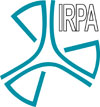 |
|---|
http://www.euronuclear.org/e-news/e-news-37/EPE2012.htm

The international scientific conference EPE (Electric Power Engineering) 2012 took place from 23-25 May, in Brno, in the Czech Republic. This annual conference, now in its thirteenth year, was organised by the Department of Electrical Power Engineering at the Faculty of Electrical Engineering and Communications of Brno University of Technology. The conference is dedicated to analysis and discussion of problems relating to power engineering in the area of science, research and work experience. It provides an excellent platform for the exchange of information, focused debate and networking among those who work in industry, education and research.
Among the many interesting papers presented during the conference was the following detailed report written by Ondrej Zlamal on some of the fusion-related devices operated at the Rez Nuclear Research Institute, near the Czech capital, Prague.
(The Editor-in-Chief)
By Ondřej Zlámal: Centrum Výzkumu Řež s.r.o., Section 8100, Department 8140, Husinec-Řež, čp. 130, 250 68 Řež, Czech Republic, www.cvrez.cz tel: +420 266 172 337, email: zla@cvrez.cz
Paper introduces experimental devices on LVR-15 reactor with focus on capacities on field of fusion applications. CV Rez is involved in two fundamental R&D activities for fusion devices and ITER, in particular: durability of plasma-facing materials is tested for "Blanket" section and tritium extraction from Pb-Li melt is investigated for "Test Blanket Module" section, both from ITER project.
Paper provides basic insight on TW3 rig, BESTH device and MeLiLo loop, the three testing and experimental devices for fusion. Results, engineering obstacles and achieved goals are presented along with perspectives for future development.
Keywords: fusion, LVR-15, experimental devices
Centrum Výzkumu Řež s.r.o. (hereinafter referred as Research Centre Rez, abbreviated as RCR), the daughter company and successor of Ústav jaderného výzkumu Řež a.s. (hereinafter referred as Nuclear Research Institute, abbreviated as NRI) on the field of research reactor’s operation and development of experimental devices has extensive experience in exploitation of out-of-pile and in-pile experimental devices for fusion applications. NRI and RCR’s employees gained such experience in several task and grants carried out for EU-based fusion-related agencies such as European Fusion Development Agreement (EFDA) and Fusion For Energy (F4E). Strong background of many years of reactor water loop’s operation should be also taken in account.
This paper deals mostly with fusion-oriented experimental and testing devices operated in Řež:
BESTH device,
MeLiLo loop,
TW3 rig.
First deeper involvement with fusion research was made in 2002, when NRI was approached by EURATOM-IPP.CR Association with offer on participation in EFDA Programme.
EURATOM-IPP.CR consists of four institutes of Academy of Science of the Czech Republic (Institute of Plasma Physics, J. Heyrovský Institute of Physical Chemistry, Nuclear Physics Institute and Institute of Physics of Materials), two prestigious faculties of Czech universities (Faculty of Mathematics and Physics under the Charles University in Prague and Faculty of Nuclear Sciences and Physical Engineering under the Czech Technical University) and two commercial research subjects (NRI and Institute of Applied Mechanics Brno, Ltd.); in total EURATOM-IPP.CR can provide about 80 scientists and technicians dedicated to fusion research.
EURATOM-IPP.CR’s utilization of NRI -and later RCR- capacities for participation on EFDA research programme was mainly based on fact that NRI operated the strong source of neutrons, the LVR-15 research reactor, and has long-term experience with development, operation and evaluation of its experimental devices. Certain tasks under EFDA’s Work Programme for 2003 year required material irradiation up to several dpa (displacement per atom, measure of absorbed dose from particle flux, most often neutrons), which cannot be obtained from other neutron sources in reasonable time-frame. The first EFDA task delivered to NRI through the EURATOM-IPP.CR was focused on the EUROFER 97 corrosion investigation under the neutron irradiation and was followed by HIP joint studies under the cyclic heat load.
In the first years, NRI involvement in EFDA tasks was mostly aimed on the investigation studies under the Test Blanket Module (hereinafter referred as TBM). TBM is one of in-vessel components planned for ITER tokamak; its purpose is circulation of lithium-enriched lead, which transmutes tritium 3H, once irradiated by fusion-generated neutrons. Tritium is then extracted, purified and used as a fuel for fusion reaction. Such applications have very high demands on used materials, mainly the construction steels. NRI offered experimental facilities for testing EUROFER 97 steel and by 2002 its specialists started to develop and later operate PbLi in-pile rig, which circulated liquid PbLi melt around EUROFER 97 samples. Inconsiderable results with EUROFER 97 steel were obtained from performed investigations as given in [17, 20, 21, 22].
Year after, EUROATOM-IPP.CR Association became interested on another field of EFDA research: testing of First Wall mock-ups (often abbreviated as FW or PFW, where PFW stands for Primary First Wall and means testing of materials which are expected to be used only in first, not-final version of First Wall). NRI received another EFDA task, which focused on thermal cycling of joint between beryllium tiles and copper alloy in the in-pile environment. This task was later followed by another one, more urgent, where slightly larger mock-ups were tested out-of-pile. Both tasks required development and building of unique devices, which are described down in the text.
At the break of 2007, the Fusion For Energy (F4E) was established as the EU’s joint undertaking for ITER and development of fusion energy.
Contrary to EFDA, F4E is aimed on commercial procurement of selected components, services and systems for ITER; by its nature, F4E took over few of former EFDA tasks, which were performed in NRI. Transferred tasks had partly commercial background and their governance by F4E was generally welcomed.
As given above, since 2002 several EFDA tasks were carried out in NRI, both in-pile (in the LVR-15 reactor) and out-of-pile (without irradiation from LVR-15 reactor). In frame of three of them, experimental and testing devices were developed and commissioned for full-power operation. In chronological order, the following tasks were realized in NRI and RCR:
TW3-TVB-INPILE: Development, commissioning and operation of the rig for in-pile thermal fatigue testing of two actively cooled mock-ups to check the effect of neutron irradiation on the Be/CuCrZr joint under the representative PFW operation conditions.
TW4-TVB-TFTEST2: Development and commissioning of out-of-pile testing device for long-term thermal fatigue testing of actively cooled mock-ups.
TW5-TTBC-005: Development of key components for PbLi Ancillary system.
All above given tasks resulted in development, manufacturing and commissioning and later operation of following experimental devices:
TW3 rig was developed under the TW3-TVB-INPILE task. TW3 rig is the only device of all three discussed in this paper operated in-pile.
BESTH device was developed under the TW4-TVB-TFTEST2 task. BESTH is abbreviation for Beryllium Sample Thermal testing. BESTH device is operated out-of-pile and partly served as technology testing for TW3 rig.
MeLiLo was developed under the TW5-TTBC-005task. MeLiLo stands for Metal Liquid Loop and is operated out-of-pile.
3.1 TW3 rig
Even though TW3-TVB-INPILE task was received as the first one of all discussed, its complexity and demands postponed its finishing after the successful ending of both above mentioned tasks.
The objectives of TW3-TVB-INPILE task were to develop, construct, commission and operate in-pile rig for continuous cyclic thermal fatigue loading of Be/CuCrZr joint on actively cooled FW mock-ups. The measures of merit were set as 20 000 thermal cycles up to 0.5 MW/m2 heat flux and 0.6 dpa of absorbed neutron dose.
The reason for investigation of effects of thermal cycling under the irradiation conditions is to simulate FW materials performance under the expected operation mode of ITER: in general, it is anticipated that ITER will be most likely operated in approx. 400 seconds long pulses as given in [18, 19]. Pulse operation generates thermal shocks on used FW materials, which have to withstand significant heat and neutron fluxes during the start-up and cool-off transients of each pulse. Especially HIP joint between plasma armour (Beryllium) and heat sink material (Copper alloy) is under extreme load: HIP stands for Hot Isostaic Pressing, diffusion joining technique, where two materials are bond together at pressures above 100 MPa and temperatures above 550°C for several hours. During the HIP bonding, diffusion joint between both materials is made, but it must be qualified for ITER operation, meaning thermal fatigue and radiation damage. As given in [7, 24], in-pile testing of FW materials is ongoing worldwide with single important goal: to investigate performance of materials under conditions as close to ITER as possible. In particular the effect of radiation degradation is of highest importance as such deterioration can not be simulated by other means.
It should be mentioned NRI and later RCR were assigned to investigate influence of given neutron source on selected materials; no consideration of different spectra on LVR-15 reactor and ITER were required from EFDA/F4E even though such difference appears to be crucial: thermal neutron source such as LVR-15 research reactor can not simulate fast neutron spectrum with 14 MeV peak, which is typical for fusion devices. As given in [23], LVR-15 neutron lethargy fluency decreases significantly before reaching 10 MeV and almost no >10 MeV neutrons are available in any irradiation position of the LVR-15 reactor. Such fact must be taken in account when evaluating results of irradiated mock-ups; EFDA TW3-TVB-INPILE task did not required any consideration of different neutron spectra and often inquiries from NRI/RCR to EFDA/F4E were not clearly answered. With no official recognition of this issue, it is commonly accepted that reason for using thermal spectrum instead of fast + 14 MeV peak spectrum lays in deficiency in reliable fusion devices and excess of research reactor’s irradiation capacities.
On advice of EFDA scientific unit, the heating with graphite panel was used as generator of required heat flux in TW3 rig. Its advantages lay mostly in using of DC current, relatively high resistance to neutron deterioration, simple design and related low operation and construction costs. As the task goes on, the biggest disadvantage seems to be in impossibility to perform even the simplest repairs on the rig itself: once inserted in the LVR-15’s core and irradiated, the rig is forbidden for any manipulation except the final irreversible disassembling, when the rig is cut open and irradiated mock-ups are retrieved by means of cutting from rig’s internal installation.
In the first years of TW3-TVB-INPILE task, the various designs of heating panel and used graphite grades and insulating ceramics were investigated, resulting in selection of meander-shaped R 8710 isostatic graphite grade panel with Si3N4 low Yttrium doped ceramics as given in [3, 4, 5, 9]. Such selection was supported by results from TW6-TVM-TFTEST and TW4-TVB-TFTEST2 tasks performed on BESTH device and also by experience gained during out-of-pile testing of TW3, when several types of ceramics and graphite grades were tested.
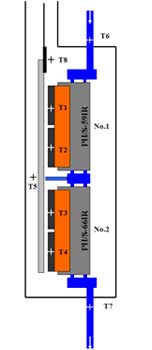
Fig. 1: TW3 rig schematics
Due to limited space in LVR-15 core and dimension of irradiated mock-ups, the serial setting of both mock-ups was used: the mock-ups are connected by middle mixing block; the cooling water enters the upper mock-up first and then passes through the lower mock-up to the reactor pool. It should be mentioned that reactor pool water is used for cooling instead of the separated cooling circuit as used on other experimental devices. Due to mock-up dimensions and requirements on low heat losses, TW3 rig occupies two cells in the reactor core.
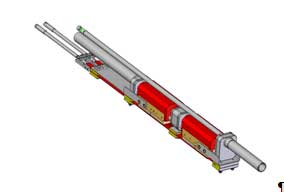
Fig 2: 3D model of TW3 rig without metal sheath
Serial connection of both mock-ups led to development of plane and thin heating panel, which is placed on top of Beryllium tiles as given on Fig. 1. The Beryllium tiles are given in black, CuCrZr alloy in orange, stainless steel body of both mock-ups is dark grey, heating panel is light grey and cooling water pipes are printed in blue. Position of measuring thermocouples is also given. As shown on Fig. 1, the 1-2 mm gap between Beryllium and heating panel ensures no short electric circuits leak into the mock-up bodies but on the other hand heat losses are kept as low as possible.
In frame of TW3-TVB-INPILE, the TW3 rig was tested out-of-pile in two shorter screening tests, totalling about 6 000 cycles. Screening tests were performed in order to verify TW3 rig’s design, power conditions and gather data for in-pile operation. Such data were later used for application to the Czech nuclear regulator, State Office for Nuclear Safety (SUJB), which is the governing body over the nuclear safety on all nuclear installations in Czech Republic, including LVR-15 research reactor. TW3 rig is experimental installation with significant impact on nuclear safety; hence the approval from SUJB was required for its in-pile operation. Such approval was obtained on the eve of 2011 and since January 2012 the TW3 rig is in full operation. TW3 rig was operated in-pile for the first time in K136 reactor campaign, in position D1/D2 as shown on Fig. 3, see [6], where purple cells represent IRT-4M fuel (with control rods if marked with central point), white “B” cells stand for Beryllium reflector and green dotted cells are water displacers; central section on D4/D5 and E4/E5 in the core was filled with Iridium irradiation cells with central void in Beryllium reflector; cells C10/C9 and D10/D9 are long time occupied with DONA irradiation channel for Silicone doping.
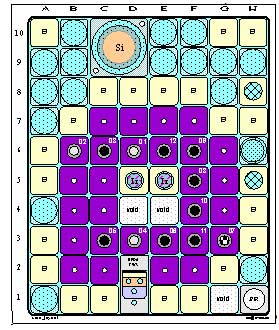
Fig 3: K136 core with TW3 rig in position D1/D2
Similar to out-of-pile operation, TW3 rig generates 7 minutes long cycles during the in-pile operation. The DC powered heating graphite panel needs 30 seconds to heat to full power (9.2 kW), 180 seconds to keep full power, 30 second to cool down to zero power and 180 seconds to keep on zero power. The full power is computed to generate 0.5 MW/m2 over the whole Beryllium surface, which was also measured on calorimetry of cooling water during the out-of-pile screening tests.
The TW3 rig is operated only with LVR-15 reactor on full power; as a result, significant radiation heat is generated in all rig materials. Metal sheath, which is in direct contact with reactor pool’s water, is cooled independently and almost no heat is transferred from it to the mock-up due to helium atmosphere around the mock-ups. Similarly almost all radiation heating generated in mock-ups is removed by its cooling circuit where flow-rate, inlet and outlet temperatures are measured for calorimetric evaluation.
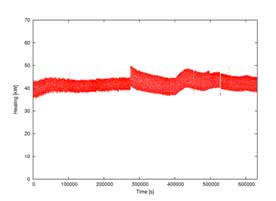
Fig 4: Calorimetric data recorded during K136 reactor campaign
Although the radiation heating strongly depends on fuel burn-up, fuel loading pattern and mostly also on the position of reactor control rods, as indicated on Fig. 3, it was evaluated that average radiation heating power of 38.77 kW with 0.98 kW of standard deviation is generated in the rig as given on Fig. 5, excluding metal sheath which is cooled independently; see [5, 6] for further details. The recorded calorimetric heat from K136 campaign

Fig 5: Distribution of radiation heating during K136 reactor campaign
With total weigh of rig irradiated materials as 5 615 g, it can be calculated that average radiation heating rate is about 6.9 W/g. Relatively high value is still under evaluation and can be explained by presence of elements significantly lighter than Iron, such as Beryllium or Carbon, which moderate neutrons more effectively. Decrease in thermal neutron flux is depicted on Fig. 6: scale given in key on the right ranges from 2·1013 to 2.6·1016 neutrons/cm2/s.
In order to generate 20 000 cycles as required TW3-TVB-INPILE task objectives, TW3 rig is expected to be operated in 6 campaigns, starting with K136 on January 2012 and ending with K141 on June 2012. According to dose calculations performed in MCNPX code with ENDF/B-VII library (MT444 cross section in particular) and methodology from SPECTER program (see [10]) on TW3 rig model given on Fig. 2, it is expected approx. 0.6 dpa will be accumulated in Beryllium by the end of irradiation. Such value is in concurrence with requirements from task objectives.

Fig 6: Thermal neutron flux (En < 0.625 eV) in LVR-15’s core with TW3 rig
After finishing of irradiation, TW3 rig is slated to be kept several months under the water shielding in LVR-15 reactor’s wet depository. During this period, residual heating will be removed and certain radioactivity decrease is expected. Rig will be then cut open, first in LVR-15 reactor’s hot cells, where mock-ups will be retrieved from metal shielding. Second, most precise cutting shall take place in NRI’s semi-hot cells, where smooth ending of each cooling water pipes will be finished. Clean cuts with no metal chips are required as mock-ups are planned for further testing in Forschungszentrum Juelich (FZJ) in Germany on JUDITH device equipped with electron beam. JUDITH device is world-wide unique device (see [11]), which is able to generate heat fluxes up to 20 MW/m2; JUDITH will continue with and finish TW3-TVB-INPILE task.
As mentioned in [7], similar in-pile test with FW mock-ups was carried out in RIAR Dimitrovgrad, in cooperation with NIIEFA Eframov, but only 3700 cycles were reached before the testing rig experienced heating panel’s failure. With several times higher number of generated cycles under the similar similar irradiation conditions, TW3 rig appears to be world-wide unique device.
3.2 BESTH device
BESTH device was developed under the TW4-TVB-TFTEST2 task and served for mock-up testing under the TW6-TVM-TFTEST task as described in [8, 9].
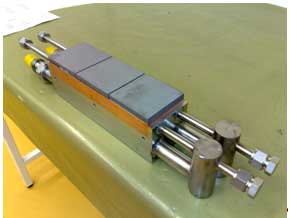
Fig. 7: FW mock-up before testing in the BESTH device
Slightly larger mock-ups were tested in BESTH device than in TW3 rig as it was not limited by LVR-15 core’s dimension restrictions. BESTH device is stand-alone testing installation housed in Beryllium Laboratory in Mala Chemie building, next to the LVR-15 premise.
BESTH device consists of two glove boxes connected to separate cooling system; inside of each glove box, the heating vessel is accommodated. Each heating vessel can test 2 mock-ups at once hence 4 mock-ups could by tested in one run. Both glove boxes are connected to separate ventilation system with HEPA filters; whole laboratory is having its own air-ventilation system as well as whole building of Mala Chemie. This assures no Beryllium vapours can be released to environment as they need to be treated as hazardous material.
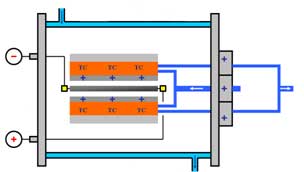
Fig. 8: BESTH heating vessel with 2 mock-ups
In principle BESTH device uses same technology for heating material mock-ups as TW3 rig: DC powered graphite heater is used to generate heat flux of 0.625 MW/m2 which is then removed through the tested mock-ups into the cooling water as referred in [9]. Calorimetric measurement based on cooling water flow-rate and Δt between inlet and outlet water temperature is used for heat flux evaluation, taking in account flat heating profile of whole meander-shaped graphite panel. As the panel is surrounded by two mock-ups, one from each side, only negligible heat is transferred to the heating vessel. Nevertheless heating vessel is actively cooled in order to avoid its overheating after long-time runs (in range of weeks).
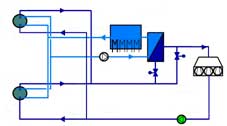
Fig. 9: BESTH cooling circuits
All heating power generated by graphite panel is transferred through the cooling circuit with plate heat exchanger out of laboratory into the cooling mini tower. The returning water is conditioned in order to keep inlet water temperature stable. The scheme of cooling circuit with two heating vessels, heat exchanger, electric heaters and cooling mini tower is shown on Fig. 9.
In frame of TW4-TVB-TFTEST2 and TW6-TVM-TFTEST tasks seven mock-ups were tested. Five of them were standard 12 000 cycles long thermal fatigue tests of FW mock-up from various suppliers: from China, Russian Federation, South Korea, EU and USA, see [1, 2, 14, 15, 16]; last two mock-ups were ordered by F4E for life-time durability test, lasting 30 000 cycles as given in [13]. All mock-ups were tested to heat flux of 0.625 MW/m2 and duration of cycle as 30 seconds heating up, 180 seconds of full power, 30 seconds cooling down and 60 seconds of power off.

Fig. 10: Ultrasonic testing of Be/CuCrZr joint soundness
Each mock-up was non-destructively tested by ultrasonic examination for soundness of Be/CuCrZr joint. Such examination was carried out twice on each mock-up: before commencing of testing in BESTH device and after its finishing. Typical output of ultrasonic testing is given on Fig. 10. It should be mentioned all tested mock-up performed almost flawlessly, including mock-ups from life-tie durability test as given in [1, 2, 13, 14, 15, 16]. Other effects of long-time testing were negligible as shown on Fig. 7 and Fig. 11.
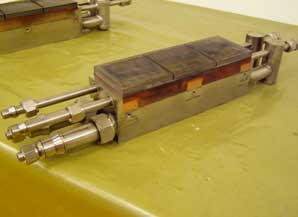
Fig. 11: FW mock-up after testing in the BESTH device
Each tested mock-up was transported for further high heat flux testing in FZJ, where it was tested on JUDITH II device, similarly as described in [1, 2]. Detailed description of JUDITH II is given in [12].
At the beginning, NRI involvement in fusion started with interest on the field of EUROFER investigation. Participation on this field was later expanded and in frame of TW5-TTBC-005 out-of-pile loop with PbLi melt was constructed and commissioned under the name “MeLiLo” as given in [17]. The MeLiLo was later also utilized under the task TW6-TTMS-003.
Both tasks focused on further development of TBM; TW5-TTBC-005 aimed on feasibility of TBM technologies, while TW6-TTMS-003 investigated corrosion of EUROFER 97 steel. European efforts on the field of TBM are closely connected with liquid metals, thus need of PbLi loop existed.
MeLiLo is simple pipe loop which circulates PbLi melt in the temperature range of 280-550°C. Such significant temperature drop is necessary for investigation of solubility of PbLi melt’s impurities, mostly corrosion products from wetted pipes. Low temperature is kept in “cold trap”, special column with metal chip filling, which is used for separation of impurities.

Fig. 12: MeLiLo schematics with cold trap and flange test section on left and pump with drain tank on right
The key components of MeLiLo (pump vessel and cold trap vessel) are made of EUROFER 97, other parts are made of DIN 1.4903 (pipes, pump internals, cold trap filling) and CSN 17 xxx grade steel (drain tank and pump impeller wheel). Loop is equipped with several sampling points which allow extract PbLi melt samples before and after the cold trap.
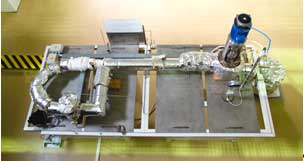
Fig. 13: MeLiLo top view
Under the TW5-TTBC-005 task MeLiLo was successfully utilized for development of key components of TBM Ancillary System such as pump, cold trap and flange, see [17]. Later involvement in TW6-TTMS-003 task was focused on long time (in range of thousands full power hours) operation, when EUROFER 97 samples were examined and investigation on PbLi melt’s corrosion potential was done.
RCR involvement on fusion field is not over: further EFDA tasks are in negotiation, both on field of FW and TBM, several own projects are carried out under governance of R&D programs from the Ministry of Education, Youth and Sports (MSMT) and Ministry of Industry and Trade (MPO) and most importantly RCR bids for F4E’s call on procurement of full-scale component testing facility, which should be built under the SUSEN project.
Also, in frame of SUSEN project, further utilization of PbLi liquid eutectic’s experience is slated for incoming years: in-scale mock-up of TBM is expected to be built for investigation of remote handling apparatuses.
NRI and RCR are active on field of fusion research for last 10 years. Both institutions closely cooperate with EURATOM-IPP.CR Association, EFDA, F4E and other private, public and governmental bodies.
Significant advance in utilization of Rez capacities in fusion was made since beginning of millennium, similar only to advance in fusion as whole. Both NRI and RCR work hard to expand its involvement in fusion and availability of LVR-15 research rector is their biggest asset.
This article was prepared under the financial support from MSMT EUPRO II project LE11012 “Project of participation support in EFDA fusion programs”. Author wishes to express his gratitude to Michal Koleska for his cooperation on TW3 rig’s radiation heating evaluation and Jaroslav Ernest for providing Figures 3 and 6.
Zacchia, F., Bellin, B., Lorenzetto, P., Bucci, Ph., Frayssines, P.E., Leibold, J.M., Oresic, B., Thomser, C., Schmidt, A., Roedig, M., McDonald, J.M., Lutz, T.J., Youchison, D.L., Ulrickson, M.A., Zlamal, O., Klabik, T., Masarik, V. Fabrication and Testing of the EU FW Qualification Mock-up, 26th Symposium on Fusion Technology, 2010, Porto, Portugal.
Zacchia, F. et al Fabrication and Testing of the EU FW Qualification Mock-up, 23rd IAEA Fusion Energy Conference, 2010, Daejon, Republic of Korea.
Klabik, T., Zlamal, O., Hajek, P., Zmitkova, J. TW3-TVB-INPILE: In-pile thermal testing device for Primary First Wall Mock-ups with Becladding, Part I: Preparation of the test rig, UJV-Z2678, 2009, Rez, Czech Republic
Zlamal, O., Klabik, T., Muhlbauer, P., Bellin, B. TW3-TVB-INPILE: In-pile thermal testing device for Primary First Wall Mock-ups with Be cladding, Part II: Out-of-pile 1000 cycles test run, UJV-Z2817, 2010, Rez, Czech Republic
Zlamal, O., Klabik, T., Zmitkova, J., Bellin, B. TW3-TVB-INPILE: In-pile thermal testing device for Primary First Wall Mock-ups with Be cladding, Part III: Out-of-pile 5000 cycles test run, CVR-Z030, 2012, Rez, Czech Republic
Zlamal, O., Vsolak, R., Klabik, T., TW3-TVB-INPILE: Start-up and first 100 cycles data on TW3 rig, K136 reactor campaign, CVR-Z060, 2012, Rez, Czech Republic
Litunovsky, N., Gervash, A., Lorenzetto, P., Mazul, I., Melder, R. In-pile testing of ITER first wall mock-ups at relevant thermal loading conditions, Journal of Nuclear Materials, vol. 386-388, 2009, pp. 979-982, ISSN: 0022-3115
Klabik, T., Zlamal, O., Masarik, V. Description of Thermal Fatigue Testing Equipment for Be coated Primary First Wall Mock-ups, UJV-13213, 2009, Rez, Czech Republic
Zlamal, O. Aktivni testovani vzorku PFW, 11. Mikulasske setkani mlade generace CNS, 2011, pp. 72-78, ISBN 978-80-02-02360-9
Grenwood, L.R., Smither, R.K. SPECTER: Neutron Damage Calculations for Materials Irradiations, ANL/FPP/TM-197, 1985, Argonne, Illinois, USA
Roedig, M., Duwe, R., Ibbott, C., Jacobson, D., Le Marois, G., Lind, A., Linke, J., Lorenzetto, P., Peacock, A., Plochl, L., Schuster, A., Severi, Y., Vieider, G., Visca, E., Weichers, B. Thermal fatigue tests with actively cooled divertor mock-ups for ITER, Fusion Engineering and Design, vol. 39-40, 1998, pp. 551-557, ISSN: 0920-3796
Majerus, P., Duwe, R., Hirai, T., Kuhnlein, W., Linke, J., Roedig, M. The new electron beam test facility JUDITH II for high heat flux experiments on plasma facing components, Fusion Engineering and Design, vol. 75-79, 2005, pp. 365-369, ISSN: 0920-3796
Zlamal, O., Wikman, S., Klabik, T., Masarik, V., Vsolak, R., Bellin, B. TW6-TVM-TFTEST: Thermal Fatigue Test of Be Coated Primary First Wall Mock-ups (tests), Test Campaigns of 110/80 Wide Mock-ups, CVR-Z031, 2011, Rez, Czech Republic
Klabik, T., Zlamal, O., Masarik, V. Final technical test report: FWQ-RF-2, UJV-Z2529, 2009, Rez, Czech Republic
Klabik, T., Zlamal, O., Masarik, V. Final technical test report: FWQ-CN-05, UJV-Z2588, 2009, Rez, Czech Republic
Klabik, T., Zlamal, O., Masarik, V. Final technical test report: FWQ-KO-2, UJV-Z2530, 2009, Rez, Czech Republic
Berka, J., Frybort, O., Hajek, P., Kosek, L., Masarik, V., Splichal, K., Vsolak, R., Burda, J., Keilova, E., Skoumalova, Z. Components of the Helium Cooled Pb-Li Test Blanket Module, internal report, 2011, Rez, Czech Republic
How, J. Project Integration Document PID, ITER_D_2234RH, Version 3, 2007, Cadarache, France
How, J., Reichle, R. PD – Plant Description, IDM UID 2X6K67, 2009, Cadarache, France
Splichal, K., Zmitko, M. Corrosion behaviour of EUROFER in Pb-17Li at 500°C, Journal of Nuclear Materials, vol. 329-333, Part B, 2004, pp. 1384-1387, ISSN: 0022-3115
Splichal, K., Berka, J., Burda, J., Zmitko, M. Fracture toughness of the hydrogen charged EUROFER 97 RAFM steel at room temperature and 120°C, Journal of Nuclear Materials, vol. 392, Issue 1, 2009, pp. 125-132, ISSN: 0022-3115
Splichal, K., Berka, J., Burda, J., Keilova, E., Lahodova, Z., Masarik, V., Viererbl, L., Zmitko, M. In-pile Corrosion and Radiation Effect Testing of EUROFER Weld Material and Pb-17Li Melt, EFDA Task TW2-TTMS-003b, Final report, UJV-13419M, 2010, Rez, Czech Republic
Lahodova, Z., Viererbl, L., Vsolak, R., Zlamal, O. Možnosti využití reaktoru LVR-15 a jeho experimentálního zázemí pro jadernou fúzi, CVR040, 2011, Rez, Czech Republic
Roedig, M., Ishitsuka, E., Gervash, A., Kawamura, H., Linke, J., Litunovski, N., Merola, M. High heat flux performance of neutron irradiated plasma facing components, Journal of Nuclear Materials, vol. 307-311, 2002, pp. 53-59, ISSN: 0022-3115
http://www.euronuclear.org/e-news/e-news-37/AREN.htm

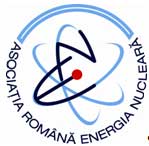
On 21 March 2012, the Romanian Nuclear Energy Association (AREN) held its Annual General Assembly. The main focus of the meeting, apart from presenting a report detailing recent events, was to submit an action plan featuring many initiatives proposed by the Romanian chapter of the Young Generation Network (YGN). The goal of these activities is to bring nuclear power closer to the people through information campaigns and trust and to point out its benefits for Romania.
The first of these activities took place on 27 March, when a team of nuclear specialists, both young and senior, met with young members of the National Liberal Party of Romania. During a two-hour seminar they discussed the present and future of nuclear power in Romania. The seminar was presided over by the former Minister of Economy, Mr. Varujan Vosganian, who is a national liberal, and by Mr. Teodor Chirica, who is on the Board of FORATOM. Other presenters included members of Young Generation Network (YGN) in Romania, who established a close relationship with the young politicians.
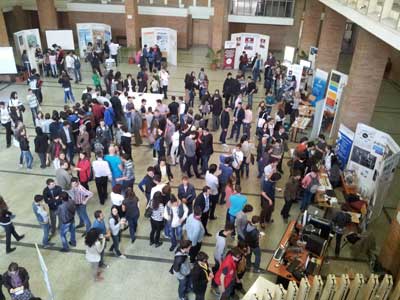
Currently, the country is building two additional units at the Cernavoda NPP site and has plans for a second NPP. Future decisions regarding nuclear power in Romania will have to be made by these young politicians, who represent the country’s future leaders. With this in mind, AREN plans to invite all political parties to take part in seminars and debates that it is organizing with its young members.
Targeting a much younger public, AREN’s YGN representatives took part in an education fair at the Politechnica Institute, whose objective was to attract more students to the nuclear power sector. The fair took place at the university, from 5-7 April 2012 and around 500 high school students visited our exhibition stand.
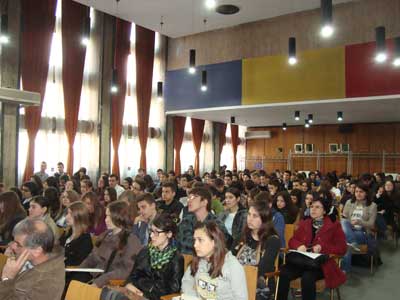
AREN continued with this series of seminars dedicated to school and high school students. On 27 April, the Association brought together nuclear specialists and pupils to discuss various topics and to give practical demonstrations about the uses of radioactivity in medicine, agriculture, industrial applications, waste disposal and reactor design, technology, fission and fusion reactors, etc. In 2011, AREN organized 4 of these seminars, which enjoyed great success, with around 150 pupils participating in each one. Many requests had been received from high schools for their pupils to take part in visits and lectures.
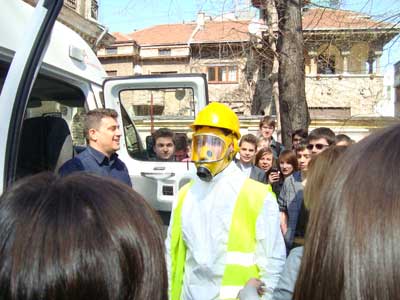
At the same time, the national company Nuclearelectrica SA, which is the operator of Cernavoda NPP, is carrying out an extensive public information programme and cooperating closely with AREN in promoting nuclear power to all categories of the public. A series of seminars for pupils that are organised by Nuclearelectrica started back in March. They combine theoretical information given by nuclear experts with practical data, and all in a language that is understandable for young people. During the latest of these seminars pupils had the opportunity to experiment with a fully-equipped and operational mobile monitoring station, which Cernavoda NPP uses to measure the level of effluents around its facility.
Working with YGN has proven to be a very efficient strategy, as children promote our messages effectively with their families and school friends.
http://www.euronuclear.org/e-news/e-news-37/romania.htm

The Extreme Light Infrastructure (ELI) is a major European Infrastructure project that is to be carried out in three European countries - the Czech Republic, Hungary, and Romania.
The Nuclear Physics pillar, ELI-NP, located in the Magurele Physics Research Campus, near Bucharest, Romania, will be funded from Structural Funds provided within the framework of the Sectorial Operational Programme called Increasing Economic Competitiveness.

When it starts up, the ELI-NP will be the most advanced research facility in the world focusing on the study of nuclear physics studies and its applications - a task it will accomplish with the help of two 10PW, ultra-short pulse lasers and the most brilliant tunable gamma-ray beam machine currently available in the world. This €290M project will be built between 2012 and 2016. The facility will be dedicated to working in fields such as frontier fundamental physics, new nuclear physics and astrophysics, as well as on applications for studying nuclear materials and radioactive waste management, materials science and life sciences.
The brilliant gamma ray beam that provides tunable energy of up to 20 MeV, which is obtained by the back-scattering of optical photons on electrons from a LINAC beam that generates energy of up to 720 MeV. This machine will open up new possibilities for high resolution spectroscopy at higher nuclear excitation energy levels. With their many doorway states, damping widths and chaotic behaviour they will lead to a better understanding of nuclear structure at a large range of excitation energy levels.
With regards to ion acceleration, this high power laser allows the production of 1015 times denser ion beams than are currently achievable with classical acceleration. The cascaded fission-fusion reaction mechanism can then be used to produce very neutron-rich heavy nuclei for the first time, which are relevant for analysis of nucleosynthesis.
The gamma beam itself can be used to map the isotope distributions of nuclear materials or radioactive waste remotely via Nuclear Resonance Fluorescence (NRF) measurements. At lower energy levels of around 100 keV the high resolution of the beam is very important for protein structural analysis. In addition, it will produce low energy, brilliant, intense neutron and positron beams, which will open up new research possibilities in the fields of materials science and life sciences.
Compared to former gamma-ray machines, the much improved bandwidth of this machine is decisive to the functioning of this new facility. Several experiments, like a parity violation experiment, only become possible thanks to this much improved bandwidth.
In addition to enabling the carrying out of a wide range of fundamental physics projects, ELI-NP will also facilitate a variety of other applied research projects. The new production schemes for the production of medical isotopes via (γ,n) will have high socio-economical relevance. ELI-NP will be implemented in this field using the highest concentration of researchers from Central and Eastern Europe specialised in the laser and nuclear physics. The high density of innovative companies located in the region, as well as top-ranked universities in Bucharest, will provide the basis for the creation of a pole of excellence and an innovation cluster at the facility. ELI-NP will thus impact positively not only fundamental science, but also on the industrial community at both a local and international level. Its social impact in Romania is of major importance to counteract the country’s brain drain, by providing the motivation for top young researchers - who might otherwise seek to go abroad in search of better professional opportunities at large scale research centres - to remain in Romania.
ELI-NP will allow for applied R&D in unrivalled conditions, which will prove important for companies active in the fields of medicine (radionuclides and hadron-therapy), telecommunications (materials in high intensity radiation fields), engineering industry (non-destructive testing), security (scanners based on nuclear resonance fluorescence of sensitive nuclear materials) – to name just a few.
Collaboration with universities in Romania and abroad are - and will be - established, for the mutual benefit of the community and of the infrastructure, by providing staff and students of academic institutions the opportunity to work in a cutting-edge facility. The facility will also provide staff and students with a chance to receive specialised training within the scope of ELI-NP.
The policy of access to ELI-NP, as well as to the other ELI centres, will be on eof open access, free for members of the scientific community. Paid access will be granted to companies.
The buildings will be completed by the end of 2014 and the new facility will inaugurated in 2016, with the operational phase starting at the beginning of 2017. Employing over 200 full-time researchers and engineers (including 60 PhD students), ELI-NP will be visited by a large number of external research teams each year, teams selected by an international committee based exclusively on the quality of their research proposals.
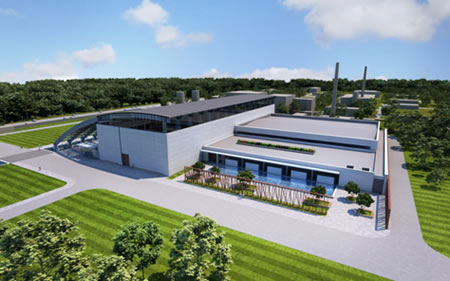
http://www.euronuclear.org/e-news/e-news-37/hungary.htm

Two recent events have had a significant effect upon the nuclear community in Hungary. The first event is the Annual General Assembly of the Hungarian Nuclear Society (HNS), which took place at the end of May 2012. This is the most important event that the Society organizes each year and its main objective is to approve the Activity Report of the previous year (2011), as well as the annual budget of the following year (2012). In addition, at this year’s Annual General Meeting the President of the Society for the period 2013-15 was elected. The new Presidency was organised by the Society’s current President and Secretary, as well as by 10 members. At the same time a new Supervisory Board was also elected. The new President will take over his position and carry out his duties as of January 1, 2013. Information introducing the Society’s new officers will be communicated in ENS NEWS early next year.
The second event is the setting up of a new company within the MVM Hungarian Power Companies Ltd., called MVM Paks II NPP Development Ltd. The mission of the new company is to carry out preparatory work on two new units at the Paks NPP site, which will prove a total capacity of 2-3000 MWe. The new units will be operational as of 2020. The call for proposal (i.e. the tender document) is to be issued before the end of the year. The potential site locations for the new units are illustrated on the diagram below.
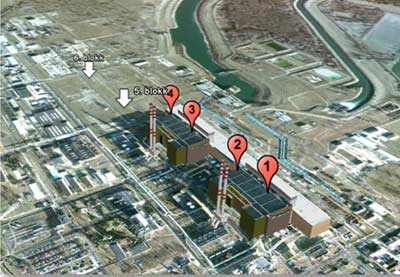
In addition, a top-level Governmental Committee on Nuclear Energy has been set up to coordinate strategic decisions related to all NPP development activity in Hungary. The Committee is headed by the Prime Minister and the two ministers responsible for the economy and development are also members of it. The aforementioned activities show that Hungarian decision-makers consider the use of nuclear energy for long-term energy production is essential for Hungary.
http://www.euronuclear.org/e-news/e-news-37/cern.htm

Students at the Institute of Nuclear and Physical Engineering at the Slovak University of Technology, in Bratislava, visited the cutting-edge scientific centre at CERN (Conseil Européen pour la Recherche Nucléaire), which is located on the French-Swiss border, not far from Geneva (the state border runs right across the main CERN site, called Meyrin).
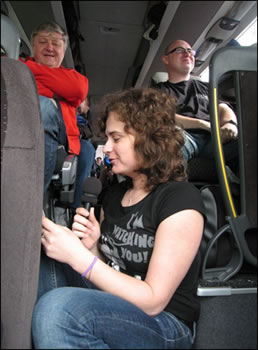
Student’s presentation in the bus
The excursion was organised by the Institute of Nuclear and Physical Engineering and the Slovak Nuclear Society as a reward for the Institute’s best performing students. The visit received financial support in the form of a Pontis Foundation Scholarship offered by Slovenske Elektrarne, a member of Enel group.
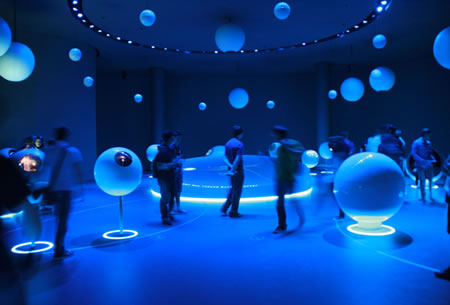
Exhibition in the Globe
The main mission of CERN is to provide particle accelerators and other equipment necessary for research in the elementary particle physics. CERN was set up in 1954 by 11 European countries and now involves 20 member states, 2,400 employees and 10,000 users from 113 nations.
Our 15-hour bus trip began on 5 May with the first of several interesting stops - at the Schaffhausen waterfalls on the German-Swiss border. An hour spent in a beautiful area with thundering water and an ancient castle was very refreshing after a night spent in the bus.
After three more hours on the bus passengers were livened up by information on CERN given by students over the on-board microphone. The information related to a variety of topics, including CERN Nobel prize-winners, particle accelerators, matter and antimatter, black holes and the highest peaks in the Alps. An hour later we were getting off the bus in the small town of Saint-Genis-Pouilly, which is located above part of the largest accelerator - the Large Hadron Collider (LHC).
The main programme began the next day, on May 7, after breakfast, when we visited the CERN laboratories. First of all we took a photo in front of Globe of Science and Innovation building – a wooden sphere that houses an exhibition featuring CERN’s activities.
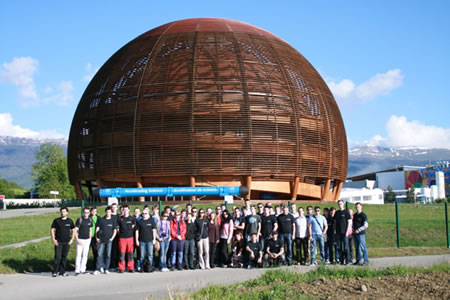
In front of the Globe
Our expert guide was Peter Chochula, who works with one of the LHC detectors, called ALICE (A Large Ion Collider Experiment). He comes from Bratislava and we appreciated hearing his explanation in Slovak. In the main auditorium we learned that the LHC is the most cold and empty place in the known universe. Its magnets are cooled down to 1.9 K (universe 2.7 K) and a vacuum is a factor of 2 lower than in the universe (LHC 10-14 bars vs. universe 10-12 bars). The collider perimeter is equipped with more than 9000 superconducting magnets, producing a magnetic field of 8.6 T. The total length of the titan-niobium fibres in the magnet coils is more than 5-times the distance from the sun to planet earth.
The LHC accelerates two beams of protons or lead ions and generates 600 million collisions per second. Today, the LHC can produce particles with energy of up to 4 TeV and after its upgrade next year the figure will rise to 7 TeV. Protons enter the LHC at a velocity close to the speed of light and make 11,000 cycles per second on the LHC, which increases their energy. Among the most important of CERN’s achievements are the detection of W and Z bosons; the confirmation of three generations of mass thanks to the LHC’s predecessor – the LEP (Large Electron Positron Collider); the production of the first atoms of anti-hydrogen in 1995, (today hydrogen anti-atoms can be maintained for more than 1000 s); the demonstration of the violation of CP parity - a possible key to understanding the disequilibrium between matter and antimatter in the universe. We also learned about five recipients of the Nobel Prize that had worked at CERN and about the OPERA experiment, which is investigating the oscillations of neutrinos.
After the introductory presentation we moved to the largest LHC detector, ATLAS (A Toroidal Large ApparatuS), or rather to the building located above it, since the detector itself is 100 m under the surface and inaccessible due to the high ambient radiation levels. Our guide for the ATLAS visit was Dr. Stanislav Nemecek, from the Czech Republic. The ATLAS detector was commissioned four years ago and measures everything that happens when protons or ions collide, creating very large amounts of energy. At present, the most sought after particle is the Higgs boson that is, according to the standard model, responsible for the mass of elementary particles. We saw a 3D movie on the installation of ATLAS, which weighs 7,000 metric tons and is 44 m long. We then visited the control centre where data are collected and distributed for further processing.
Accompanied by Viliam Senai, also from Slovakia, we moved to the hall where components for the LHC are assembled and disassembled. We had a possibility to look inside the dipole and quadrupole magnets, see the accelerating cavity and learn how shrinking during cooling down is resolved. All LHC magnets are arranged with an uncertainty of 100 micrometers. The final destination, the so-called “dump” for beams from the accelerator, is the cavity in Jura Mountains - on the other side of Lake of Geneva - where an unbelievable 350 MJ of nominal energy are dumped.

ATLAS, the largest LHC detector at CERN
After lunch at CERN we continued with a visit of the Globe of Science and Innovation and the Microcosm exhibition inside. The afternoon was devoted to a sightseeing tour of Geneva. We saw its famous, beautiful water fountain, the flower watch and the place there Empress Sissi was attacked by an assassin, Saint Peter’s Cathedral. We also saw the Reformation Wall –the national monument of Geneva and Helvetia - and took a boat trip on Lake Geneva. Our programme ended at the Square of Nations.
On our way back we stopped off at Beznau NPP, which is home to the world’s oldest operational power reactor (43 years in operation with prospect of another 10 years to go). Six very pleasant ladies showed us around the plant. Beznau is one of four NPPs in Switzerland that satisfy 40% of Swiss electricity demand. The remaining 60% are provided by hydropower stations. Beznau has two units producing 365 MW of electricity. The thermal power produced by each of the two pressurized water reactors is 1130 MW. The cleanliness of all the workplaces that we visited was very impressive. All the equipment looked as if it had only been in operation for a few years, not 43 years. The cooling of the plant is assured by the river Aare, which flows around the island on which the plant is located.
Next morning, at 2:30 a.m. we arrived home, very impressed with all that we had seen during this interesting excursion.
Andrea Sagatova,
A participant in the excursion
http://www.euronuclear.org/e-news/e-news-37/sne-news.htm

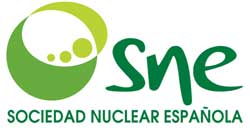
A new Board of Directors to govern the Spanish Nuclear Society was elected during the General Assembly of 22 May. The current President is Lola Morales and the Vice President, Francisco J. Lopez, will become President after the next General Assembly, on February 2013.
The 38th Annual Meeting that will be held from 17 to 19 October 2012, in Caceres, is already open for registration. All relevant information about the meeting is available at: www.reunionanualsne.es.
The Plenary Sessions will deal with current important nuclear issues. The topics proposed for this year’s meeting are as follows:
The centralised temporary storage facility for irradiated fuel
Impact of Fukushima on the continuous improvement of safety
Challenges of the new nuclear generation
There will be also three monographic sessions this year, which will focus on the following subjects
Nuclear emergency plans
New safety requirements: International organisations’ approach
Energy models and climate change
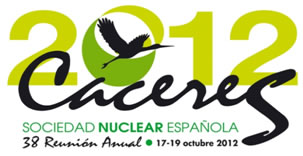
The Young Generation Nuclear network is pushing actively in the area of education and training for young people, organizing new editions of its Annual Seminar on Safety of Advanced Reactors, Basic Course of Nuclear Science and Technology and Seminar on Nuclear Fusion at the ETS of Industrial Engineering at the Polytechnic University of Madrid, and the at the Polytechnic Centre of the University of Zaragoza.
The Young Generation Nuclear network will present the candidacy of the Spanish City of Burgos for the 2014 edition of the International Youth Nuclear Congress (IYNC)
Nuclear España, the monthly magazine of SNE, which has been published since 1984, has produced two editions, 324 and 328, that featured information, in English and Spanish, on the 37th Annual Meeting and the winter session entitled: Nuclear Power Plants in 2011: Experiences and Perspectives.
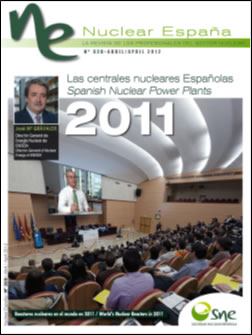
SNE has published its annual call for candidates for the award of 5 scholarships, each to the value of € 3,000, devoted to encouraging the enrollment of students for Masters and/or postgraduate courses in nuclear science and technology. All information is posted on the website of the SNE (www.sne.es)
WiN Spain has created its own website, which was recently made available to the public. Visit it at: www.winspain.es
2012 marks the 30th anniversary of the magazine of the SNE, Nuclear España (Nuclear Spain). To celebrate this occasion a special edition will be released in July-August and a special ceremony will take place at the 38th Annual Meeting, in Caceres (see above).
http://www.euronuclear.org/e-news/e-news-37/croatia.htm

From 3-6 June, the Croatian Nuclear Society (HND), in cooperation with the International Atomic Energy Agency (IAEA), the European Nuclear Society (ENS), the State Office for Radiological and Nuclear Safety (DZRNS) and the Faculty of Electrical Engineering and Computing (FER) of the University of Zagreb, successfully organised the 9th edition of the international conference entitled: Nuclear Option in Countries with Small and Medium Electricity Grids. The conference took place at Hotel Kolovare, in Zadar, a beautiful city on the Adriatic coast.
The conference programme was rich and diverse, covering topics that included Energy Planning and the Nuclear Option, Safety Culture and Public Relations for Radioactive Waste Management and Decommissioning. More than 50 papers were presented by experts from the nuclear industry, regulatory authorities, the academic sector, consultancies and institutions. More than 90 participants from 13 countries worldwide attended the conference.
As a part of the conference programme, a Young Authors Competition (YAC) was held to motivate young authors to present their work at events like this. Two authors received prizes for the articles they had written: Raul Gonzalez, from the University of Pisa, Italy, and Kaliopa Mancheva, from Risk Engineering Ltd., Sofia, Bulgaria.
Since this conference is organised biannually by the Croatian Nuclear Society, we are already looking forward to welcoming you again to Zadar, in 2014.
Dea Milovan - Croatian Nuclear Society | Conference Secretary - University of Zagreb | Fac. of Elec. Engineering and Computing | Dep. of Power Systems
http://www.euronuclear.org/e-news/e-news-37/finland.htm

The annual meeting of the Finnish Nuclear Society was held in Tieteiden talo, Helsinki on March 13th, 2012. During the meeting Dr Liisa Heikinheimo from TVO was elected the new President of ATS and Anna Nieminen, from VTT, was elected the Society’s new Secretary. Timo Vanttola from VTT and Tapani Raunio from Fortum were also nominated to new members of the Board.
Petri Kinnunen, from VTT, gave a presentation about the Jules Horowitz project and Finnish participation in it. Heikki Suikkanen and Ville Rintala received the 2011 Erkki Laurila award, which is given to the best scientific article published in the ATS Ydintekniikka magazine. The article was dealing with modeling and computer simulation works of pebble bed reactors at the Lappeenranta University of Technology.
The Energy Channel was founded in spring 1990 by seven active women working in the nuclear field. It was established as a working group of ATS and at present it has nearly 80 active members. Energy Channel celebrated its 20th anniversary in the Glo Hotel on 23 March, 2012. The event was opened by the minister of economic affairs Jyri Häkämies. Presidents of all three nuclear power companies, Fortum Power and Heat, TVO and Fennovoima, and the waste management company Posiva, presented their greetings. All together 63 female leaders and members participated.
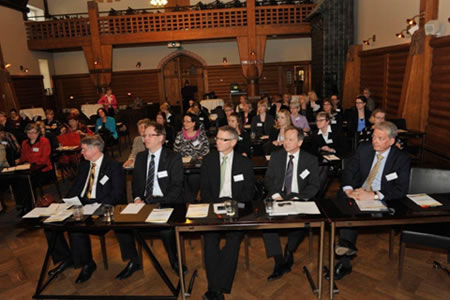
Energy Channel celebrated its 20th anniversary in March 2012. The Precidents of Fortum, TVO, Fennovoima and Posiva presented their greetings.
http://www.euronuclear.org/e-news/e-news-37/YG-Reporter.htm


From 22-26 April, the TopSafe 2012 conference took place in Helsinki, under the auspices of the European Nuclear Society (ENS) and the International Atomic Energy Agency (IAEA).
Barely a year after the Fukushima nuclear accident sufficient knowledge has been gained about the detailed sequence of events that lead to the complete blackout of several reactor units at the Fukushima Daiichi and Fukushima Daiini sites. With such a compilation of data and supporting analyses relating to the accident now available, the timing for TopSafe 2012 was especially appropriate.
As a result of the Fukushima accident, several countries have subjected their nuclear energy programmes to thorough scrutiny. In view of this, the nuclear industry and nuclear research institutions are carrying out a thorough process aimed at understanding the causes and consequences of such events, as well as the lessons to be learnt from them.
The Opening and Plenary Sessions of the conference defined the scope of the subsequent presentations and poster sessions, and underlined the actions undertaken by different international organisations since the accident. In Europe the rapid coordinated countermeasures that were taken, e.g., the so called “stress tests,” significantly diminished the negative impact of the accident upon public opinion.
Tero Varjoranta, Director General of the Finnish Nuclear and Radiation Safety Authority, STUK, stated that trust is hard to earn but easy to lose, which makes every accident, and even lesser incidents, extremely harmful to the nuclear industry. In Finland, STUK is one of the most trusted authorities and during the Fukushima accident it was the main source of information for media and public alike. This effectively decreased the public’s level of anxiety. The authority was aware of the situation and of the reports of possible hazards. Sometime after the accident occurred, STUK reported that it had detected a few dozen micro bequerels of iodine from Fukushima per cubic meter of air, a fact that was notified almost exclusively by the tabloid press and didn’t make the headlines in the broadsheets.
The highlight of the first Parallel Session, entitled Lessons Learned from Fukushima, was the presentation by Akira Kawano, from the Tokyo Electric Power Company (TEPCO), in Japan. Mr. Kawano's presentation provided first-hand information about the development of events at Fukushima since the earthquake of March 11, 2011.
In the aftermath of the tsunami that struck the Eastern coast of Japan, workers and operators at the Fukushima site had to work under very tough and restrictive conditions, including a lack of electrical power, high radiation doses, lack of instrumentation readings, the threat of a hydrogen explosion hazard and the debris caused by the earthquake and subsequent tsunami. His presentation put into perspective the human dimension of the crisis, during which several workers agreed to put their lives at risk in order to secure the opening of the pressure relief valves.
The session that ran parallel to the Lessons Learned from Fukushima one focused on external hazards. Alain Chabod, from AREVA, reviewed the safety features of the EPR within the post-Fukushima context. His presentation gave an analysis of the robustness of the EPR design in the face of extreme external hazards, such as earthquakes, external flooding and total loss of outside power or ultimate heat sink. He concluded that the EPR design provides good resistance and margin to cope with Fukushima-type accidents. But, nevertheless, some additional measures have been identified to further eliminate possible cliff-edge effects.
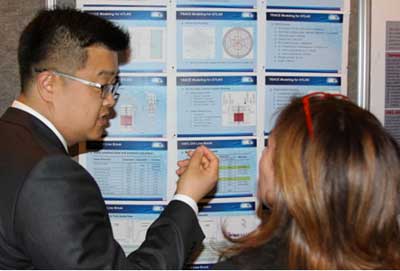
The Monday morning started with a poster session
Moving on to the Best Estimate Codes and Methods session, speakers from nuclear research institutes and nuclear design and construction companies shared the results they have obtained from several safety-related analyses, mostly dealing with the simulation of transients in LWRs. This series of presentations triggered very fruitful discussions about the necessity of best estimates and uncertainty calculations being accepted by licensing bodies. Participants active in the fields of design and licensing launched debates on this issue.
The second parallel session of the Tuesday morning, which focused on safety assessments, included an interesting review of the safety design of the new AP1000 reactor. The accident that featured in this session was a small break LOCA and the presentations focused on the impressive passive mitigation features of the design. In the same session representatives of the NRG (the Dutch Nuclear Energy Consultancy), gave a talk about the key differences between the various European EPR designs. The study that the talk was based on analysed the principal differences between the Olkiluoto and the Flamanville/UK EPR designs, concentrating on why there are differences between the two. While country specific regulations were identified as the main reason for these differences, several other reasons were also identified.
In another session, which was also related to best estimate calculations, a very interesting presentation about hydrogen combustion analyses by CFD methods was given. Although the representation of non-uniform hydrogen concentration is still under development, this methodology looks promising not only to assess the evolution of hydrogen combustion, but also to assess the impact of such combustion on the systems, structures and components of nuclear power plants. During this session the development and qualification of an atmospheric monitoring system was also discussed.
Towards the end of the second day, a session was devoted to the topic of Safety Culture & Management of Safety. The presentations given during this session made it very clear that, unless appropriate programmes are implemented, a considerable amount of the knowledge gained by nuclear designers and operators over the years may be lost due to the retirement of a significant percentage of them. Although this shortfall in knowledge management was identified several years ago, not all affected parties have implemented the policies needed to overcome the problem. At present, the IAEA is working on a paper that reflects the experience cumulated in the reinforcement of safety culture through knowledge management initiatives.
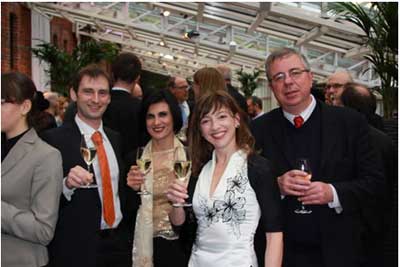
The conference dinner was held at the Ravintola Sipuli, in an excellent setting
On the last day, the topics discussed ranged from education, training and risk-informed decision making to future nuclear installations. In the latter session some aspects of lead-bismuth cooled reactors, as well as pebble bed and fusion reactors, were examined.
Dr. Harri Tuomisto gave an interesting presentation on the unexpected in the nuclear industry. He described the ``Black Swan'' context, which refers to a highly unlikely event that has considerable consequences and for which there was no prior hint that it might occur. He came to the conclusion that all three major accidents, Three Mile Island (TMI), Chernobyl and Fukushima, fall into the category of known unexpected accidents and as such are not “Black Swans”. The WASH-1400 report by Rasmussen et al. revealed the possibility of a TMI-like accident. The positive feedbacks from RBMK were also known about (but apparently not by operators). Furthermore, historical data clearly reveals the possibility of tsunamis exceeding 10 meters in height occurring in Japan.
Dr. Tuomisto’s presentation generated a lively discussion on the existence and justification of residual risk and of whether the Fukushima accident was a residual risk or not. In Dr. Risto Himanen's opinion, there is no such thing as a residual risk and there are only higher probability and lower probability risks. For practical reasons actions are first taken in response to more probable risks. However, low probability risks are not neglected. Instead, they are reconsidered if their relative importance has increased as a result of actions taken in response to other risks. The audience seemed to be unanimous in the view that the Fukushima accident could not be categorised as a residual risk, even if such risks do exists. However, with proper PSA, including the external events, the core damage frequency would have been closer to 10^-2/a rather than the 10^-4/a given prior the accident.
After all the sessions had concluded, the closing session of TopSafe 2012 featured presentations on nuclear knowledge management and global nuclear safety and security. After these presentations, general information about conference participation and research was communicated. Then a final Questions and Answers session took place, during which the main emphasis was on the aftermath of the Fukushima accident and on the views of the nuclear industry with regards to the future.
A debate on the consideration of beyond-design-basis events as a licensing requirement then took place. Debate on this issue revolves around the re-consideration of what is deemed to be an “acceptable risk” for the nuclear industry. Although the debate remains an open one, the main encouraging conclusion of this conference is that, in spite of the crisis experienced by the nuclear sector in 2011, growth is still foreseen. However, additional safety analyses and tests may be required, and those countries that were committed to nuclear energy before 11 March 2011 are still committed to nuclear power generation today.
TopSafe 2012 culminated in a technical visit to the Visitor Center and underground repository for low- and intermediate-level waste at the Olkiluoto NPP. The EPR at Olkiluoto is almost finished on the outside, but interior work continues and the planned start-up of operations is 2014. Even from a distance the plant was impressive, with the two operating medium-sized BWRs next to it.
Eric Dorval, Lauri Rintala, Ville Valtavirta
ENS-YG Reporters
Aalto University, School of Science
http://www.euronuclear.org/e-news/e-news-37/chernobyl.htm

A visit to the Chernobyl site where, in 1986, the terrible nuclear accident occurred is a challenging but interesting project for nuclear engineers. Part of the German Nuclear Society’s Young Generation network (GYG) had already visited the site in 2010. The Austrian Nuclear Society Young Generation network (AYG) was also trying to arrange a visit to the Ukraine.
Together with Markus Zink, Eileen Radde planned and organised not only the logistics of the visit but also the 4-day programme. Denys Zenyuk was the organiser from the Ukrainian side and we would once again like to thank him for his invaluable help.
The excursion started on Thursday, 17 May, when the tour party flew from Frankfurt, Munich, and Düsseldorf, via Vienna, to Kiev. The afternoon was free for people to get a first impression of Kiev. In the evening Denys invited us to a concert in the Art44 club in the centre. (Photo 1)

Photo 1: Concert at the ArtClub 44
On Friday morning the bus for Chernobyl picked us up at 7:45. Under normal conditions, the journey to the site takes about 2 hours. Our first appointment was scheduled for 10:00. However, 20km before we reached the zone our bus stopped unexpectedly; it had broken down. Our bus driver tried to repair the bus, and we eventually managed to continue for another 300m. Once again it was repaired. In the meantime, we had already organised a replacement, which was a good thing because our bus only made it another 5km (Photo 2).
Photo 2: First breakdown of our bus |
|
We used all these unplanned breaks to take our first radiation dose measurements, samples and spectra. (Photo 3). After a delay of two and a half hours we finally arrived at the Chernobyl zone. We had to cancel the visit to the spent fuel facility and the control room of unit number 3, but lunch was saved.
On the way to Unit 4 of the Chernobyl NPP we measured a dose rate increase as we progressed along the road, which we couldn’t explain initially. After more detailed discussions we figured out that because of the construction works for the shelter project that were taking place trucks were moving out of the construction area without any prior decontamination. It would, therefore, have been useful to dust protect the roads, cover the road with bitumen or spray the trucks before leaving the zone.
The measurements were taken using an ATOMTEX Backpack system, and analysed with Google Earth. The values are in µSv/h, and the increase as we approached the construction site was clearly visible from 0.5µSv/h up to 1 – 1.3µSv/h. All measurements were taken inside the bus and can be seen in Photo 4.
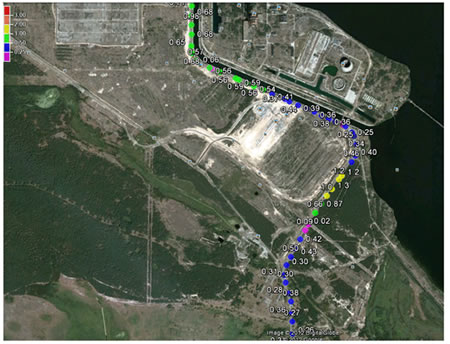
Photo 3: Increase in dose rate
 Photo 4: Inside the shelter house |
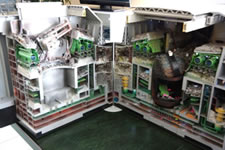 Photo 5: Model of reactor |
The first part of the visit inside the zone was to the shelter hall, where all information about the new shelter project is provided. We were informed about the current status of the project, why the new shelter is necessary and which parties are contributing to the project.
The shelter hall is directly opposite to Chernobyl Unit No. 4, but due to security issues we were not allowed to take any photos.

Photo 6: Our group
The group picture in front of Chernobyl Unit No. 4 (see above) was a must, before we were driven off to have lunch.
|
|
After lunch we were taken to Prypiat, were we walked around in the deserted city, from the main square to the big wheel and the Palace of Culture. We discovered remains left behind by the departing inhabitants, even though many things had been taken or destroyed. Prypiat left a big impression on all of us. It sometimes seemed like time had stood still for 26 years.
As we were 2 hours behind schedule we left Prypiat at 16.00. The busses back to Kiev should have been waiting for us, but they were also 2 hours late. While waiting for the bus we were able to feed an enormous catfish from the bridge.
In the evening we had a typical Ukrainian dinner with traditional drinks.
|
|
|
|
Saturday was dedicated to sightseeing in Kiev. Denys had arranged, together with his college, a visit to the famous Lavra cave monastery. It is one of the oldest monasteries in the Russian-Orthodox church and is beautifully located on the west bank of the Dnieper river.
Afterwards we visited the Chernobyl museum, which has a special display dedicated to a 25 years memorial to the accident and a section on the recent Fukushima accident. It is interesting to note that many of the anti–nuclear posters there were printed in Austria. The exhibition was prepared with an eye for detail. Foreign visitors may encounter difficulties walking through the museum as the descriptions are all in Russian, but the museum provides audio guides in 3 languages, which were very helpful.
After a quick lunch we rented a boat for a tour on the Dnieper river, which is an impressive way to see Kiev and is highly recommended.
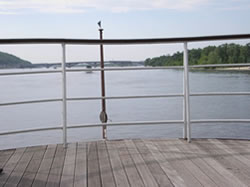 |
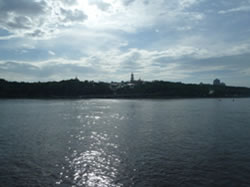 |
Photos 9 + 14: Boat Tour
After bidding farewell to our hosts and spending an evening watching a football match, we left Kiev on the Sunday. It was a nice and technically interesting tour, despite a few problems encountered along the way. We all enjoyed the Ukrainian atmosphere, hospitality and style, and we hope that some of us will return one day! Thanks again to our Ukrainian hosts!
© Eileen Radde, 2012
http://www.euronuclear.org/e-news/e-news-37/sfen-yg.htm

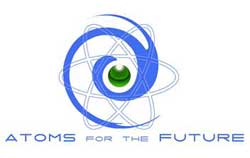
The 3rd edition of the conference Atoms for the Future will take place in Paris from the
22 - 25 October 2012. Created and organised by the French Nuclear Society Young Generation Network (SFEN-JG), this event aims to help young professionals and students to learn more about various aspects of nuclear energy and to develop their professional networking.
Offering a format of lectures and technical visits, previous Atoms for the Future conferences have brought together more than 300 participants from all over the world and received outstanding satisfaction ratings by participants. The SFEN-JG is, therefore, committed to continuing with the development of this event and invites others to share in that development and to share in the success of Atoms for the Future.
Atoms for the Future was a bi-annual event organised together with the Russian YGN. It was decided to adapt the conference’s concept by opening it up to an ever broader range of international participants (the working language of the conference is English). The conference’s name was chosen in order to be easily recognisable, portray dynamism and suggest youthful engagement. Following a meeting that took place in France, in which French and foreign students and young professionals participated, the conference was divided into two parts: lectures (2 days) and technical visits (2 to 3 days). Every year, a different theme –Topic of the Week – is defined. In 2010 and 2011 the topics were Nuclear Reactors Development and The Nuclear Fuel Cycle respectively. This year, the conference will focus on NPP Operation and Maintenance.
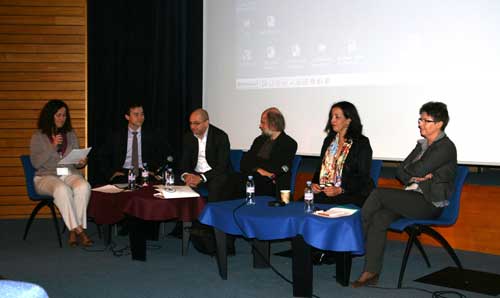
The degree of technical detail provided during the lectures and the tours is deliberately calibrated to focus the interest of both experts and “newcomers” to the particular topic. Although the lectures often start with the provision of technical information, proceedings gradually progress to more general subjects, such as economics, geopolitics or public acceptance. A considerable amount of time is also dedicated to questions & answers. We try to invite only high-level speakers with recognised skills and experience in order to captivate delegates, including senior business leaders and researchers in the nuclear field. This usually attracts lots of participants, as they don’t often have such an opportunity to meet and discuss pressing nuclear issues with the CEO or board members of large companies.
The technical tours are organised to enable participants to have access to various nuclear facilities in France that cover a broad range of facilities. These facilities feature every stage and aspect of the nuclear fuel cycle and electricity generation business, including research, mining and geological repositories, conversion and enrichment, fuel manufacturing, plant operation and reprocessing. The tours are organised for around 60 persons a year, according to the sites’ capacity for receiving visitors.
Here are three examples of facilities visited during the 2011 Atoms for the Future conference: An enrichment plant run by AREVA, a nuclear chemistry hot-lab operated by the CEA and a nuclear power plant operated jointly by EDF & GDF-Suez. Of course, during both the lectures and the technical tours much time is set aside for an informal exchange between participants during the coffee breaks and social events. This helps to build bridges and encourage networking between people and companies, another major objective of Atoms for the Future.
Every year the conference is made possible by the continuous trust shown in it by the sponsors, by the motivation of the organisers (all of whom are volunteers from SFEN-JG staff) and thanks to the support of the companies and lecturers who are willing to share their knowledge and show participants around their facilities. The core organisation team is made up of around 10 people, but many more SFEN-JG members are present during the event. The organisation of the conference, in addition to the financial help given by our sponsors, allows us to charge a nominal conference fee, thereby attracting extra participants.
So far, Atoms for the Future has attracted participants from Sweden, Belgium, Germany, Austria, Spain, Finland, the UK, Russia, Sri Lanka, Czech Republic, Italy, USA and France. Over the coming years, SFEN-JG will continue to organise Atoms for the Future, continuously striving to maintain and further improve upon the quality of the event.
The 2012 Atoms for the Future conference will take place from 22 – 25 October 2012, in Paris (France). The conference theme will be: NPP Operation and Maintenance. A range of topics will be discussed, such as site organisation, outage management, heavy components replacement, human factors, fuel for NPPs and R&D support. Visits on offer will include trips to the Chalon/Saint-Marcel facility, the Le Creusot forge and EDF’s Nogent NPP (during an outage). Fees: 50€ students, 150€ young professionals. For additional information, contact the following website and register your participation in this year’s conference: www.sfenjg.org/Atoms-for-the-Future-2012. |
http://www.euronuclear.org/e-news/e-news-37/aren-yg.htm

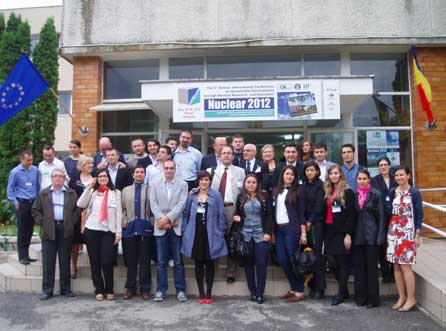
During the international Nuclear 2012 conference that was organized by the Nuclear Research Institute in Pitesti, the Young Generation chapter of AREN (the Romanian Association for Nuclear Energy) co-ordinated a workshop dedicated to the subject of nuclear knowledge transfer from senior experts to younger specialists. The concept of the workshop was to create a framework within which different generations could meet and freely discuss the issue of knowledge transfer and to select the best related practices applied by various organisations.
The guest speakers were top-level representatives of various areas within the nuclear education field, including Petre Ghitescu, a professor at the University of Bucharest; Victoria Balaceanu, an expert in engineering and design research from the Pitesti Nuclear Research Institute; Gheorghe Simionescu of CITON and Teodor Chirica of AMEC Romania, who represented the private business sector. After the lectures, Mihaela Stiopol, President of AREN, gace a concluding speech.
The senior experts in the nuclear field who were present highlighted the expectations they had for the young generation, as well as the challenges that lie ahead of them. The most significant values that young people have to accept and asssimilate in order to take over the seniors’ responsibilities are intrinsic and genuine motivation, enthusiasm, passion, integrity and honesty.
The around 50 participants that took part in the workshop were able to draw useful conclusions with regards to knowledge management best practices and the importance of effective communications between generations in order to facilitate the transferring of values and for sustaining the impetus to drive forward the nuclear community.
AREN and the Romanian Atomic Forum (ROMATOM) recently organised the latest edition of the annual Alexandru Ene children’s drawing competition and the The Atom – My friend essay writing competition.
During April and May, special activities for promoting and supporting these events were carried out in schools across Bucharest, Cernavoda, Pitesti and other towns. The announcement reached counties as far away as Hunedoara, Ialomita, Arad, Tulcea, Constanta, etc. By 28 May, 386 drawings and 48 essays had been received as entries to the competition. The participants were school and high school pupils aged up to 19 years old, who were able to show the full extent of their imagination and creativity under the supervision of their art, physics and biology teachers.
To encourage greater objectivity and transparency when it comes to judging the entries, the competition was split in to two categories: for art school and high school children, respectively. This was done in order to allow equal opportunity to both those students who have and outstanding talent for drawing and those who are only guided by inspiration and creativity when it comes handling a paint brush. The creations on display illustrated the main topics of the contest: What do we know about energy? The Atom – My friend, Nuclear Power Saves the Environment and The Energy of the Third Millennium.

The competition ended on 6 June 2012, with an exhibition at the Constantin Brancusi Hall of the Parliament Palace, where all the participants were awarded diplomas, not only the winners. Moreover, all entries to the competition were exhibited. Thus, for three days, all the artists present, tourists, children and parents popped by to admire the drawings. The mission of the jury was a difficult one, having to evaluate both artistic impression and the message conveyed by every drawing or essay.
Mihaela Stiopol, together with the Deputy General Secretary of ROMATOM, Valentina Dinu, and Young Generation Network members, Livia Chitu and Lavinia Rizea, awarded the prizes to the most talented children. Special prizes were also awarded for originality and composition. The winning drawings will be on display not just at different locations around Bucharest, but also across the country (Pitesti, Cernavoda, etc).
We would like to thank all the children who took part in the 18th edition of Alexandru Ene drawings and essays competition. We appreciate their interest, as well as the desire and creativity that they they showed in presenting and converting the atom into the nucleus of their artistic works’ universe.
The success of similar projects developed during the last school year convinced the members of the Romanian Association “Nuclear Energy” to carry on with them during this academic year. In addition, they pledged their continued support for the educational project that aims to provide students and teachers with the latest proper and accurate information about nuclear energy, starting with schools and high schools in Bucharest.
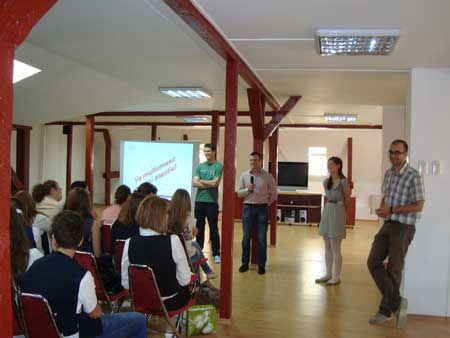
The modesty in assessing the success of such projects resulted in the realisation that one seminar scheduled for approximately 100 students is not enough. Thus, in order to facilitate the participation of as many students as possible in these seminars the project had to be extended to include three separate seminars, each addressing the same theme, Nuclear Energy – Myths and Truth. Discussions were concentrated on themes like nuclear energy, nuclear power plants and the myths and truth about radiation.
The superficial, inaccurate and sometimes unhelpful information that students can receive during classes, as well as the stereotypes that we are exposed to every day, lead to the creation of this initiative, which is aimed at dispelling the myths that surround all things nuclear.
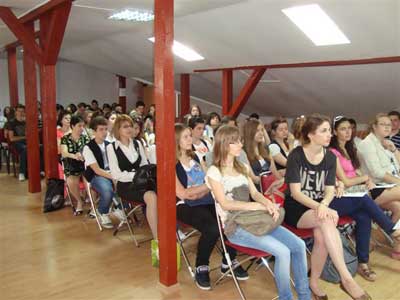
The organisers and lecturers that deliver the presentations are all members of the AREN Young Generation chapter. They signed up to the project briging all their enthusiasm and knowledge to bear to promote and disseminate better and more accurate information on nuclear energy to a large audience.
The best feedback that could have been received at the end of this project was to see the amazed and excited faces of the students as they learned how and where nuclear energy is generated, or touched a nuclear fuel bundle or discussed the advantages and drawbacks related to different sources of energy.
http://www.euronuclear.org/e-news/e-news-37/atomexpo.htm

On 6 June 2012, the ATOMEXPO 2012 International Forum, which is organised by Russia’s State Atomic Energy Corporation, ROSATOM, took place in Gostiny Dvor (Moscow).
The event brought together over 4,000 participants from 53 countries. More than 225 speakers gave presentations and reports on the most topical issues relating to nuclear energy. The main theme of the Forum was the Nuclear Power Industry Worldwide: One Year after Fukushima. Compared to last year, the number of representatives from new countries that are developing nuclear energy has doubled. Together with their colleagues from Russia, France, Germany, USA, Japan, and other countries, they discussed the prospects for international cooperation in the global nuclear market.

Participants in the Forum discussed a large range of issues, including what happened last year, possible solutions for nuclear legacy issues, the new Northern Sea Route, nuclear fuel market trends, etc. During the round table discussion on an integrated approach to the development of the global nuclear industry, representatives of companies and ministries from countries like France, the Czech Republic, Turkey, South Africa and others discussed the benefits of ROSATOM’s comprehensive proposal regarding the global nuclear energy market.
The panel debate took place on June 5. It was broadcast live on Russian TV’s Channel 24, and its moderator was the famous Russian TV anchorman, Sergey Brilev. The participants in the panel debate were: Elizabeth Dipuo Peters, the Minister of Energy of the Republic of South Africa; Alexander Ozerets, the Minister of Energy of Belarus; Alexander Lokshin, First Deputy Director General of ROSATOM; Metin Kilci, Undersecretary at the Ministry of Energy and Natural Resources of Turkey; Ian Telfer, Non-Executive Independent Chairman of the Board of Uranium One; Lawrie Haynes, President of Rolls-Royce Nuclear; Ruben Lazo, Chief Commercial Officer of AREVA; Takuya Hattori, President of Japan Atomic Industry Forum; Matti Ruotsala, Executive Vice-President of Fortum and Leonid Bolshov, President of the ATOMEXPO International Forum and Director of IBRAE RAN.
Representatives of Russian and foreign companies and ministries signed several bilateral agreements and memoranda of understanding during the Forum. On June 4, the governments of the Russian Federation and the Federal Republic of Nigeria signed a cooperation agreement for the design, construction, operation, and decommissioning of nuclear power plants in Nigeria. It was the first agreement to build nuclear power plants ever signed between ROSATOM and an African country. On the same day, the Director General of ROSATOM, Sergey Kirienko, and the State Minister for Information and Communication Technology of the Republic of Bangladesh, Yafes Osman, signed a memorandum for the creation of the first information center on nuclear energy in Bangladesh and for the training of personnel for the country’s nuclear industry. Also other signing ceremonies took place between Russian representatives and their counterparts from such countries as the USA, Mongolia, Australia, etc.
The accompanying exhibition featured exhibits from leading companies and organisations representing the world nuclear market, such as ROSATOM, TVEL, Concern Rosenergoatom, Atomenergomash, E4 Group, Kazatomprom, EdF, CEA (France), KSB, Siemens (Germany), CNNC (China), Rolls-Royce (UK) and others. The total surface area taken up by the Forum exhibition was double that of the previous year.
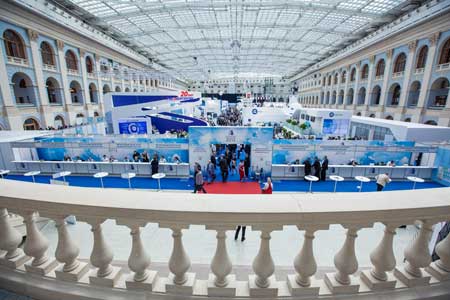
For the first time a Forum mobile guide based on Apple iOS and Google Android was launched, as an application for smart phones and PC tablets. Another first were the information booths where delegates could find detailed information about the Forum, the programme and exhibitors.
The Forum was covered by about 400 representatives of the mass media, including press and TV representatives from a number of countries. These includedg India, China, Vietnam, South Africa, Japan, Iran, Turkey, Bulgaria, Hungary, UK, Germany, Ukraine, Belarus, Poland, etc.
The Atomexpo 2013 International Forum will be held, in Moscow, from 3 - 5 June, 2013.
http://www.euronuclear.org/e-news/e-news-37/EHRO-N.htm

On 30 May 2012, EHRO-N, the European Human Resource Observatory in the Nuclear Sector, produced its first report analysing whether or not the supply of experts for the nuclear industry in the EU will meet the required demand for the region by 2020.
The report’s analysis was based on data that was collected between spring 2010 and spring 2011 and didn’t, therefore, take into account the likely impact of the Fukushima-Daiichi accident. Nevertheless, the report in its current form still provides a source of relevant information for young people considering working in the nuclear industry, higher educational institutions or companies involved in the nuclear energy sector.
In the EU today there are around 80,000 nuclear experts, equivalent to around 80 nuclear experts per 1,000 MW(e) unit. It is estimated that nuclear experts represent around 16% of the total workforce in the nuclear energy sector. This is only the tip of the competence iceberg, which also includes the so-called “nuclearised” employees (representing the biggest percentage of the nuclear energy sector workforce, at around 74%) and the “nuclear-aware” employees (representing some 10% of the same workforce).
One alarming finding to emerge from the report was that nearly half of nuclear experts employed today in NPPs in the EU will need to be replaced by 2020.
The supply of nuclear engineering graduates and graduates having included a nuclear energy-related subject in their studies (2,800 of these graduated in the EU in 2009) should cover up to 70% of the demand for nuclear experts in EU by 2020. The demand for such experts EU-wide will be, on average, 4,000 per year by 2020. This is the most optimistic scenario, based on the assumption that all eligible graduates will actually find employment in the nuclear sector.
Furthermore, non-nuclear engineers (around 3,200 per year by 2020), technicians (3,500 per year by 2020) and other graduates like lawyers, business graduates, project managers, etc. (2,500 per year by 2020) will also be in demand in the nuclear energy sector by 2020.
Demand for many of the aforementioned graduates, especially the non-nuclear engineers, will need to be met by so-called “STEM graduates”, i.e. graduates in science, technology, engineering and mathematics.
In keeping with the principle that “information is power”, EHRO-N proposes that similar surveys be conducted on a regular basis at EU level in order to forecast trends and provide information to relevant stakeholders, who can then take action accordingly. For this to happen, the work of EHRO-N needs to be actively supported by national governments (e.g. by coordinating and organising the distribution of information nationwide), nuclear safety authorities, the nuclear industry and education and training (E&T) establishments. Furthermore, ways of supporting the mutual recognition of knowledge, skills and competences relevant to the nuclear energy sector should be considered too. The European Credit for Vocational Education and Training (ECVET) initiative should also be promoted. Last but not least, coordination between industry and universities should be strengthened.
The full EHRO-N report is available at: ehron.jrc.ec.europa.eu
http://www.euronuclear.org/e-news/e-news-37/other-conferences.htm

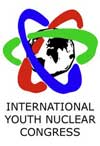
5 - 11 August 2012
Charlotte, USA
North American Young Generation
more

5 - 7 September 2012
Ljubljan, Slovenia
more

17 -21 September 2012
Como, Italy
more

24 -28 September 2012
Paris, France
more

10 - 13 October 2012
Hissar, Bulgaria
more

17 - 19 October 2012
Cáceres, Spain
more

3 - 6 February 2013
Jacksonville, Florida, USA
more

7 - 11 April 2013
Avignon, France
more
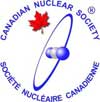
24 - 28 August 2014
Vancouver, Canada
more
http://www.euronuclear.org/e-news/e-news-37/Member-Societies.htm

Austrian
Nuclear Society |
Belgian
Nuclear Society |
Bulgarian
Nuclear Society |
Croatian
Nuclear Society |
Czech Nuclear Society |
Finnish
Nuclear Society |
French
Nuclear Energy Society (SFEN) |
German
Nuclear Society (KTG) |
Hungarian
Nuclear Society |
The
Israel Nuclear Society |
Italian
Nuclear Association |
Lithuanian
Nuclear Energy Association |
Netherlands Nuclear Society |
The Nuclear Institute |
Nuclear
Society of Russia |
Nuclear
Society of Serbia |
Nuclear
Society of Slovenia |
Polish
Nuclear Society |
Romanian
Nuclear Energy Association (AREN) |
Slovak
Nuclear Society |
Spanish
Nuclear Society |
Swedish
Nuclear Society |
Swiss
Nuclear Society |
http://www.euronuclear.org/e-news/e-news-37/Corporate-Members.htm
Links to ENS Corporate Members |
AF-Colenco Ltd., Nuclear Technology
Department |
Alpiq Ltd |
Alpiq Suisse Ltd. |
Andritz AG |
Ansaldo Nucleare S.p.A |
AREVA NP |
AREVA NP GmbH |
Atomic Energy Council (AEC) |
Atomic Energy of Canada Limited (AECL) |
Atomexpo LLC |
Atomtex SPE |
Axpo AG |
BKW FMB Energie AG |
Chilean Nuclear Energy Commisssion |
CCI AG (formerly Sulzer Thermtec Ltd) |
Design Bureau "Promengineering" |
NV Elektriciteits-Produktiemaatschappij
Zuid-Nederland EPZ (Electricity Generating Co. Ltd in the
Southern Netherlands) |
E.O.N Kernkraft GmbH |
Euro Nuclear Services BV |
Electrabel, Generation Department |
Electricité de France (EDF), Communication Division |
ENUSA Industrias Avanzadas SA |
EXCEL Services Corporation |
GE Nuclear Energy |
IEA of Japan Co. Ltd |
Japan Electric Power Information Center (JEPIC) link |
Kernkraftwerk Gösgen-Däniken
AG |
Kernkraftwerk Leibstadt AG (KKL), |
L-3 Communications MAPPS Inc. |
Linn High Therm GmbH |
Elektroinstitut Milan Vidmar |
NRG Arnhem |
NRG Petten |
NUKEM Technologies GmbH |
ONET TECHNOLOGIES |
Paks Nuclear Power Plant Ltd |
Paul Scherrer Institute |
Polimaster Ltd |
Siempelkamp Nukleartechnik
GmbH |
|
SKB (Swedish Nuclear Fuel and Waste Management
Company) |
Studiecentrum voor Kernenergie, Centre d’Etude
de l’Energie Nucléaire SCK/CEN |
Synatom |
Taiwan Atomic Energy Council (AEC) |
Taiwan Power Company (Taipower) |
"Technoatomenergo" Close Joint-Stock
Company |
Teollisuuden Voima Oyj / Industrial Power
Company Ltd (TVO) |
Tractebel Engineering S. A. |
UNESA |
Urenco Limited |
Vattenfall AB |
VNS – Vinçotte Nuclear Safety |
VTT Nuclear |
Westinghouse Electric Company |
World Association of Nuclear Operators
(WANO), |
|
http://www.euronuclear.org/e-news/e-news-37/editorial.htm

Editorial Staff:
Mark O’Donovan, Editor-in-Chief
Contributors to this Issue:
Eric Dorval (Finish YGN)
Kirsten Epskamp (ENS)
Emilia Janisz (ENS)
Dea Milova (Croatian Nuclear Society)
Dimitar Popov (ENS High Scientific Council)
Eileen Radde (Austrian Nuclear Society)
Lauri Rintala (Finish YGN)
Andrea Sagatova (Slovak University of Technology)
Mihaela Stiopol (AREN)
Marco Streit (ENS)
Ovidiu Tesileanu (National Institute of Physics and Nuclear Engineering)
Ville Valtavirta (Finish YGN)
Nicolae-Victor Zamfir (National Institute of Physics and Nuclear Engineering
Ondřej Zlámal (Centrum Výzkumu Řež s.r.o)
Realisation:
Marion Brünglinghaus
Rue Belliard 65, BE-1040 Brussels
Phone +32 2 505 30 50 - Fax: +32 2 502 39 02
E-mail: info@euronuclear.org - http://www.euronuclear.org
The ENS News is a quarterly publication, in electronic
form only.
Copyright notice ©2012 European Nuclear Society.
Reproduction is authorised provided that the ENS News is acknowledged as the
source – except where otherwise stated.
![]()
© European Nuclear Society, 2012